Half a world, and half a lifetime away.
Discussion
17th May
British peace proposals transmitted to Argentina.
The SAS team which parachuted into the sea is bundled into a Sea King HC4 from HMS Invincible and sent off to Argentina. It's going to be a one-way trip, the £4,000,000 helicopter will have just enough fuel to reach Chile after the SAS attacks Tierra del Fuego and lift off again. After it lands in Chile, the chopper will be destroyed, and the troops will turn themselves in.
Argentina's 'Navy Day', it was believed that there would be some major offensive actions.
Invincible's first CAP of the day dropped a couple of 1,000lb bombs on the Port Stanley airfield.
800 Squadron made a photo reconnaissance trip, bringing back pictures of Fox Bay, Goose Green, Port King and settlements in Lafonia.
The Sea Harriers provided defensive CAP for the Battle Group throughout the day in anticipation of any air attacks.
The Argentine Navy launched a Super Etendard attack but without the Neptune's shadowing capabilities, they had not been able to maintain their plot of the Battle Group's movements. This and deception measures put in place by the senior aviators on the British carriers meant that when the pair of Super Etendards popped up to target their Exocets, their radars swept only empty sea.
Helicopters were moved in order to prepare for the arrival of Atlantic Conveyor and her cargo.
HMS Hermes left the group in the mid-afternoon in order to rendezvous outside the TEZ with Atlantic Conveyor.
One of Hermes' Sea King 5s was lost in the evening, the aircraft had to be ditched due to instrument malfunction.
Argentine Air Force commander Brigadier Lami Dozo warned that British task force will receive 'massive attack' if it sails within range of Argentine weapons.
EEC renewed sanctions against Argentina for another week: Italy and Ireland lift them altogether.
SD.
British peace proposals transmitted to Argentina.
The SAS team which parachuted into the sea is bundled into a Sea King HC4 from HMS Invincible and sent off to Argentina. It's going to be a one-way trip, the £4,000,000 helicopter will have just enough fuel to reach Chile after the SAS attacks Tierra del Fuego and lift off again. After it lands in Chile, the chopper will be destroyed, and the troops will turn themselves in.
Argentina's 'Navy Day', it was believed that there would be some major offensive actions.
Invincible's first CAP of the day dropped a couple of 1,000lb bombs on the Port Stanley airfield.
800 Squadron made a photo reconnaissance trip, bringing back pictures of Fox Bay, Goose Green, Port King and settlements in Lafonia.
The Sea Harriers provided defensive CAP for the Battle Group throughout the day in anticipation of any air attacks.
The Argentine Navy launched a Super Etendard attack but without the Neptune's shadowing capabilities, they had not been able to maintain their plot of the Battle Group's movements. This and deception measures put in place by the senior aviators on the British carriers meant that when the pair of Super Etendards popped up to target their Exocets, their radars swept only empty sea.
Helicopters were moved in order to prepare for the arrival of Atlantic Conveyor and her cargo.
HMS Hermes left the group in the mid-afternoon in order to rendezvous outside the TEZ with Atlantic Conveyor.
One of Hermes' Sea King 5s was lost in the evening, the aircraft had to be ditched due to instrument malfunction.
Argentine Air Force commander Brigadier Lami Dozo warned that British task force will receive 'massive attack' if it sails within range of Argentine weapons.
EEC renewed sanctions against Argentina for another week: Italy and Ireland lift them altogether.
SD.
18th May
HMS Invicible's first three CAP missions drops six 1,000lb bombs on Port Stanley airfield.
Four Sea Harriers and four RAF Harriers take off from the Atlantic Conveyor to HMS Hermes.
The STUFT Europic Ferry was following with the Amphibious Group carrying RN Wessex and RAF Chinook helicopters and ground crews. Once the Amphibious Group met with the Carrier Battle Group the jets would be off the Atlantic Conveyor allowing the helicopters to be transferred for preparation.
The Carrier Battle Group and Amphibious Group rendezvous in the evening and although the Argentine Air Force miss this, they are soon provided with the information by the BBC World Service.
Hopes fade for a successful outcome to United Nations peace negotiations.
Thatcher makes statement to the Commons regarding the Falklands Situation and the status of the Peruvian Peace Plan.
SD.
HMS Invicible's first three CAP missions drops six 1,000lb bombs on Port Stanley airfield.
Four Sea Harriers and four RAF Harriers take off from the Atlantic Conveyor to HMS Hermes.
The STUFT Europic Ferry was following with the Amphibious Group carrying RN Wessex and RAF Chinook helicopters and ground crews. Once the Amphibious Group met with the Carrier Battle Group the jets would be off the Atlantic Conveyor allowing the helicopters to be transferred for preparation.
The Carrier Battle Group and Amphibious Group rendezvous in the evening and although the Argentine Air Force miss this, they are soon provided with the information by the BBC World Service.
Hopes fade for a successful outcome to United Nations peace negotiations.
Thatcher makes statement to the Commons regarding the Falklands Situation and the status of the Peruvian Peace Plan.
SD.
[quote=C&C]
Firstly SD, and everyone else that has contributed, a big thanks from me - it's one of the most interesting threads I've read on PH. I remember watching it develop on the News - I was 13 at the time, but this thread really gives a good account of what went on (and has caused me to learn much more about it via other websites, youtube documentaries etc.).
Regarding the above quote, and also the one where the BBC helpfully informed the Argentinians about the detonator issue with their bombs that weren't exploding - really? WTF were they doing??? Was there no censorship or control over what they broadcast? And even if not, how stupid could they be to broadcast this stuff knowing the Argentinians would pick it up?
ETA - Surely if anything, the BBC could/should have been used to deliberately mislead/misinform the Argentinians with false reports?
Were any lessons learned from this and later applied to the Gulf and Afghanistan?
[/quote]
The BBC has rules about impartiality - Thatcher criticised the BBC for referring to "British Forces" rather than "our boys" in her diaries. The BBC World Service was funded by the Foreign and Commonwealth Office rather than the licence fee, which did cause some friction. There are many examples of the BBC reporting that may have helped the Argentinean effort (or hindered the British). As far as I'm aware there was no strict censorship of reporting and no D-notices issued - it was all editorial judgement.
The attack on Goose Green was an example of where information was given which could have given an advantage to the Argentinian defenders but in the end it turns out that they refused to believe the reports and thought they were a diversionary tactic. (I will cover this later on the appropriate date).
Interestingly, many servicemen hold a deep resentment for the BBC from this time.
Maybe censorship in the age of 24 hour rolling news and instantaneous communications is the subject for another thread?
SD.
Firstly SD, and everyone else that has contributed, a big thanks from me - it's one of the most interesting threads I've read on PH. I remember watching it develop on the News - I was 13 at the time, but this thread really gives a good account of what went on (and has caused me to learn much more about it via other websites, youtube documentaries etc.).
Regarding the above quote, and also the one where the BBC helpfully informed the Argentinians about the detonator issue with their bombs that weren't exploding - really? WTF were they doing??? Was there no censorship or control over what they broadcast? And even if not, how stupid could they be to broadcast this stuff knowing the Argentinians would pick it up?
ETA - Surely if anything, the BBC could/should have been used to deliberately mislead/misinform the Argentinians with false reports?
Were any lessons learned from this and later applied to the Gulf and Afghanistan?
Edited by C&C on Thursday 18th May 14:27
[/quote]
The BBC has rules about impartiality - Thatcher criticised the BBC for referring to "British Forces" rather than "our boys" in her diaries. The BBC World Service was funded by the Foreign and Commonwealth Office rather than the licence fee, which did cause some friction. There are many examples of the BBC reporting that may have helped the Argentinean effort (or hindered the British). As far as I'm aware there was no strict censorship of reporting and no D-notices issued - it was all editorial judgement.
The attack on Goose Green was an example of where information was given which could have given an advantage to the Argentinian defenders but in the end it turns out that they refused to believe the reports and thought they were a diversionary tactic. (I will cover this later on the appropriate date).
Interestingly, many servicemen hold a deep resentment for the BBC from this time.
Maybe censorship in the age of 24 hour rolling news and instantaneous communications is the subject for another thread?
SD.
19th May
Cabinet gives approval for landings.
HMS Glamorgan spends the night of the 18/19 bombarding targets between Port Stanley and Lively Island.
HMS Brilliant and Alacrity patrol to the north of Falkland Sound.
A stream of warships, RFAs and STUFTs are still heading south from Ascension. Surveillance support is provided by a Nimrod 2P flown from Ascension.
The Battle and Amphibious Groups spend the day east-north-east of Port Stanley moving aircraft, weapons, equipment and assault units.
Realising that perhaps it would not be the best idea to sail into the assault with the entire 3,000 man brigade sitting on one cruise liner, the day is spent cross-decking troops so that not all the eggs were in one basket. By a stroke of excellent fortune, the seas were calm, allowing the small landing craft to shuttle troops around. Some 2000 soldiers are cross-decked before the weather kicks up again.
A Sea King HC.4 with thirty men aboard ditches into the sea, probably due to mechanical failure. It is surmised that a bird strike with an albatross caused the crash as feathers were found floating near the crash point. Twenty-two were lost, of whom twenty were SAS. Many of them were survivors of the South Georgia op. The pilot, Flt Lt G. W. Hawkins was the only RAF fatality of the conflict.
HMS Invincible remained in the TEZ to cover the activity. The last of 809 Squadron's Sea Harriers are flown onto her from the Atlantic Conveyor later in the day.
An additional four Harrier GR3s arrive, flown in one long hop from the UK, with multiple mid-air refuellings. The first time the pilots had ever tried landing on a carrier was in the South Atlantic.
SD.
Cabinet gives approval for landings.
HMS Glamorgan spends the night of the 18/19 bombarding targets between Port Stanley and Lively Island.
HMS Brilliant and Alacrity patrol to the north of Falkland Sound.
A stream of warships, RFAs and STUFTs are still heading south from Ascension. Surveillance support is provided by a Nimrod 2P flown from Ascension.
The Battle and Amphibious Groups spend the day east-north-east of Port Stanley moving aircraft, weapons, equipment and assault units.
Realising that perhaps it would not be the best idea to sail into the assault with the entire 3,000 man brigade sitting on one cruise liner, the day is spent cross-decking troops so that not all the eggs were in one basket. By a stroke of excellent fortune, the seas were calm, allowing the small landing craft to shuttle troops around. Some 2000 soldiers are cross-decked before the weather kicks up again.
A Sea King HC.4 with thirty men aboard ditches into the sea, probably due to mechanical failure. It is surmised that a bird strike with an albatross caused the crash as feathers were found floating near the crash point. Twenty-two were lost, of whom twenty were SAS. Many of them were survivors of the South Georgia op. The pilot, Flt Lt G. W. Hawkins was the only RAF fatality of the conflict.
HMS Invincible remained in the TEZ to cover the activity. The last of 809 Squadron's Sea Harriers are flown onto her from the Atlantic Conveyor later in the day.
An additional four Harrier GR3s arrive, flown in one long hop from the UK, with multiple mid-air refuellings. The first time the pilots had ever tried landing on a carrier was in the South Atlantic.
SD.
20th May
Royal Navy Sea King helicopter from HMS Invincible crashed on a beach near Punta Arenas in Chile. The crew of three burn their machine and go into hiding, later surrendering and being repatriated.
The first offensive mission flown by the RAF from an aircraft carrier since October 1918, was launched from HMS Hermes.
Secretary Perez de Cuellar admits the failure of UN peace talks.
Thatcher accuses Argentina of 'obduracy and delay, deception and bad faith', tells Commons of collapse of peace process and orders task force into battle.
RMS St. Helena requisitioned by the Task Force - 19 Saint Helenian sailors volunteer to serve aboard alongside naval personnel, and after the end of the War she stays in the Islands as a minesweeper.
14:15. The Task Force splits up.
HMSGlamorgan is sent to Choiseul Sound, on the East Side of East Falkland, with orders to do its best at playing a one-ship amphibious night assault, with prodigous expenditure of 4.5" HE and starshells.
The Task Force Carrier Group, consisting of the two carriers, the destroyers [i/]Glamorgan, Glasgow[/i] (Repaired for now, but it would soon return to the UK), Coventry, the frigates Arrow and Alacrity, and the supply ships Olmeda, Resource, Regent, Tidepool, Pearleaf, Elk, Fort Toronto and Atlantic Conveyor. Its job was to try to run interference for the amphibious group.
The Amphibious Group, upon which the British hopes rested consisted of:
HMS Fearless and sister ship Intrepid (Rear) Purpose-built assault ships, carrying troops and with a well deck, and carrying eight landing craft each.

RFAs Sir Galahad, Sir Tristram, Sir Geraint, Sir Lancelot, Sir Percivale.
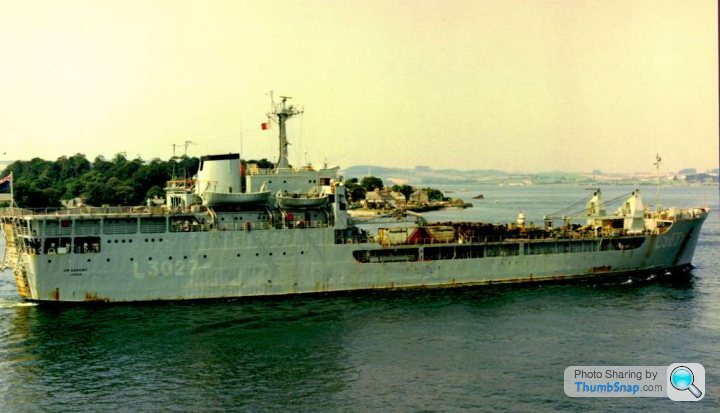
RFA Sir Geraint pictured
SS Norland, a car ferry.
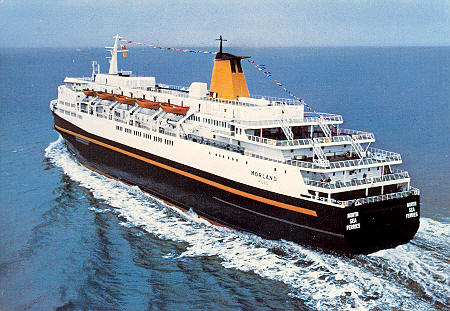
SS Norland in peacetime
SS Europic Ferry.
RFA Stromness. (later USNS Saturn)
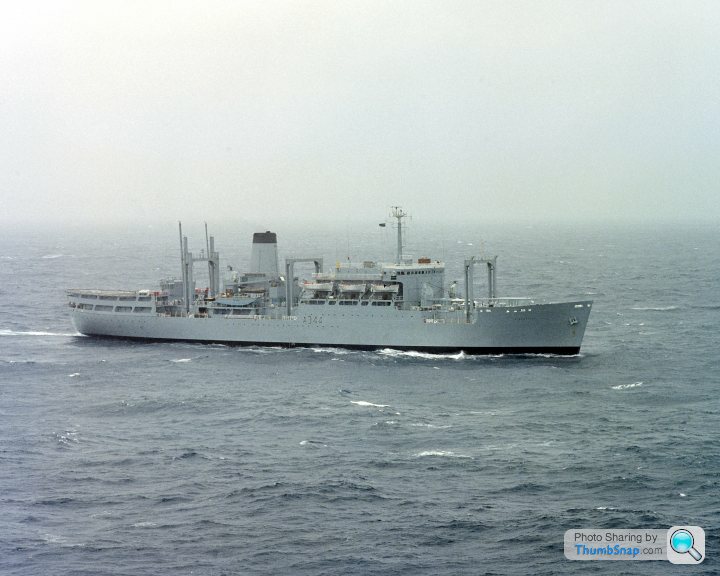
RFA Stromness
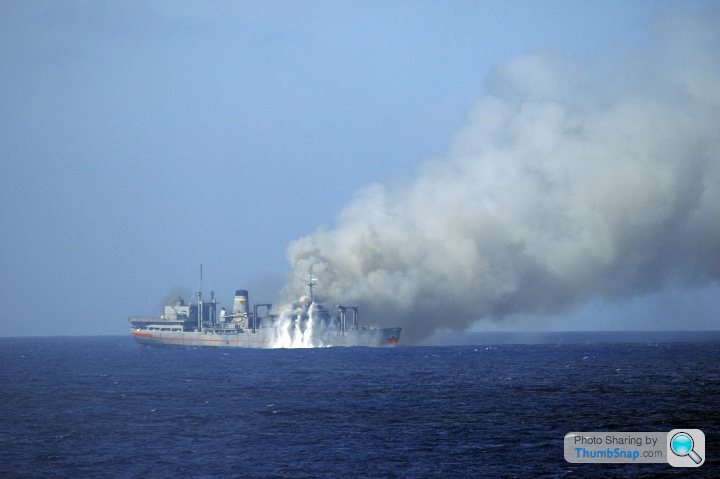
USNS Saturn (ex RFA Stromness) seen here in a SINKEX taking 20mm rounds from Phalanx on board USS Mitscher
SS Canberra, AKA The Great White Whale.
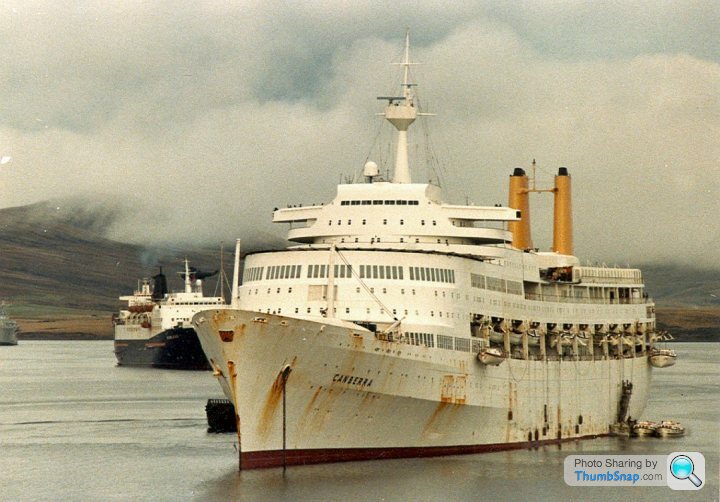
SS Canberra with the iconic Falklands rust paint scheme!
RFA Fort Austin, with a full load of helicopters.
Protecting them in what was soon to be called "Bomb Alley" were seven warships.
County Class destroyer HMS Antrim, sister ship to HMS Glamorgan. An old destroyer, with twin guns, and a rudimentary air defence system consisting of old Sea Slug missiles, and TV-Guided Sea Cats.
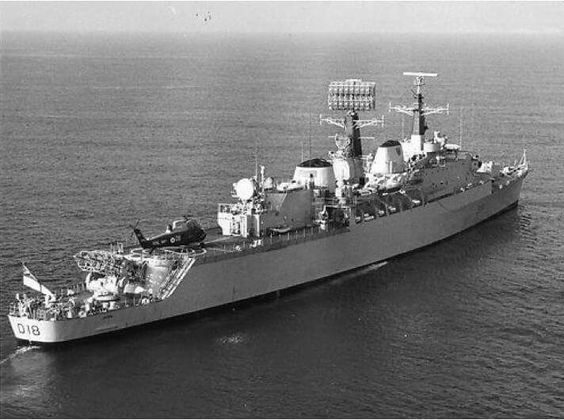
HMS Antrim
HMS Plymouth, and sister ship HMS Yarmouth. Veteran (read: old!) Type 12 anti-submarine frigate with Sea Cats and the twin guns.
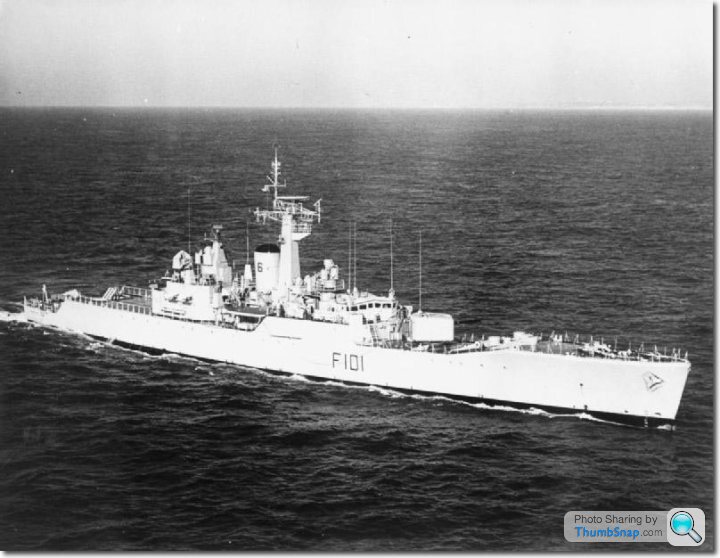
HMS Yarmouth
HMS Argonaut. Classic 'Leander' class frigate, upgraded to Exocet Leander standard. This replaced the twin gun mount with anti-ship missiles, reducing her effectiveness to 40mm cannons and Sea Cats.
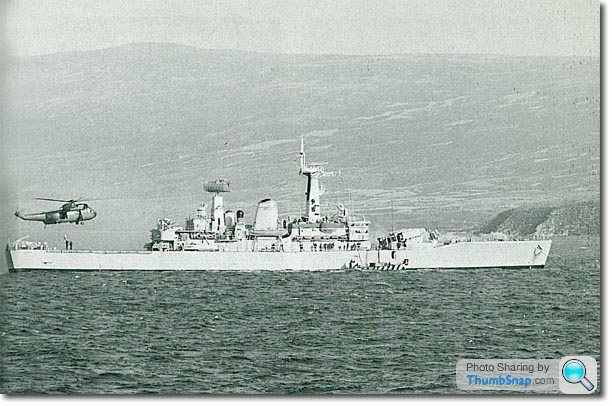
HMS Argonaut
Type 21 Anti-submarine frigate HMS Ardent. More modern Mk8 gun, and Sea Cats.

HMS Ardent
HMS Brilliant, and Broadsword. Armed with the Sea Wolf missile system, so new that one of the sailed with a Marconi rep aboard conducting after-sales support who was shanghaid for the war. Short ranged system, but well regarded.

HMS Broadsword
That was it, the entire fleet and its defences, covered by about 30 Harriers, and a little over 3,000 men assaulting enemy-held islands with over 10,000 troops and some 150 aircraft.
SD.
Royal Navy Sea King helicopter from HMS Invincible crashed on a beach near Punta Arenas in Chile. The crew of three burn their machine and go into hiding, later surrendering and being repatriated.
The first offensive mission flown by the RAF from an aircraft carrier since October 1918, was launched from HMS Hermes.
Secretary Perez de Cuellar admits the failure of UN peace talks.
Thatcher accuses Argentina of 'obduracy and delay, deception and bad faith', tells Commons of collapse of peace process and orders task force into battle.
RMS St. Helena requisitioned by the Task Force - 19 Saint Helenian sailors volunteer to serve aboard alongside naval personnel, and after the end of the War she stays in the Islands as a minesweeper.
14:15. The Task Force splits up.
HMSGlamorgan is sent to Choiseul Sound, on the East Side of East Falkland, with orders to do its best at playing a one-ship amphibious night assault, with prodigous expenditure of 4.5" HE and starshells.
The Task Force Carrier Group, consisting of the two carriers, the destroyers [i/]Glamorgan, Glasgow[/i] (Repaired for now, but it would soon return to the UK), Coventry, the frigates Arrow and Alacrity, and the supply ships Olmeda, Resource, Regent, Tidepool, Pearleaf, Elk, Fort Toronto and Atlantic Conveyor. Its job was to try to run interference for the amphibious group.
The Amphibious Group, upon which the British hopes rested consisted of:
HMS Fearless and sister ship Intrepid (Rear) Purpose-built assault ships, carrying troops and with a well deck, and carrying eight landing craft each.

RFAs Sir Galahad, Sir Tristram, Sir Geraint, Sir Lancelot, Sir Percivale.

RFA Sir Geraint pictured
SS Norland, a car ferry.

SS Norland in peacetime
SS Europic Ferry.
RFA Stromness. (later USNS Saturn)

RFA Stromness

USNS Saturn (ex RFA Stromness) seen here in a SINKEX taking 20mm rounds from Phalanx on board USS Mitscher
SS Canberra, AKA The Great White Whale.

SS Canberra with the iconic Falklands rust paint scheme!
RFA Fort Austin, with a full load of helicopters.
Protecting them in what was soon to be called "Bomb Alley" were seven warships.
County Class destroyer HMS Antrim, sister ship to HMS Glamorgan. An old destroyer, with twin guns, and a rudimentary air defence system consisting of old Sea Slug missiles, and TV-Guided Sea Cats.

HMS Antrim
HMS Plymouth, and sister ship HMS Yarmouth. Veteran (read: old!) Type 12 anti-submarine frigate with Sea Cats and the twin guns.

HMS Yarmouth
HMS Argonaut. Classic 'Leander' class frigate, upgraded to Exocet Leander standard. This replaced the twin gun mount with anti-ship missiles, reducing her effectiveness to 40mm cannons and Sea Cats.

HMS Argonaut
Type 21 Anti-submarine frigate HMS Ardent. More modern Mk8 gun, and Sea Cats.

HMS Ardent
HMS Brilliant, and Broadsword. Armed with the Sea Wolf missile system, so new that one of the sailed with a Marconi rep aboard conducting after-sales support who was shanghaid for the war. Short ranged system, but well regarded.

HMS Broadsword
That was it, the entire fleet and its defences, covered by about 30 Harriers, and a little over 3,000 men assaulting enemy-held islands with over 10,000 troops and some 150 aircraft.
SD.
21st May
All times LOCAL, not ZULU
HMS Ardent enters Falkland Sound. SBS teams are ferried by helicopter to prepare to assault a garrison position on Fanning Head.
01:30. HMS Antrim follows in.
01:45. HMS Fearless, followed by Intrepid enter the sound, by 02:30 they had made the turn to port entering San Carlos Water. The ships wells are flooded, and the landing craft prepared.
02:30. HMS Plymouth escorts Canberra, Stromness, Norland and Fort Austin into the sound, with Brilliant bringing up the rear.
03:50 HMS Antrim announces the British presence in San Carlos by commencing a bombardment of the Fanning Head position with its twin guns. After over 250 rounds were fired, the SBS teams charged in, finding 21 dead or wounded, the survivors had fled.
0600. The five 'Sirs' escorted by Argonaut and Broadsword enter.
07:30. First landing craft beach on San Carlos's water edge. 2 Para just beat 40 Commando to land, but the latter ran up the first flag, in San Carlos Settlement.
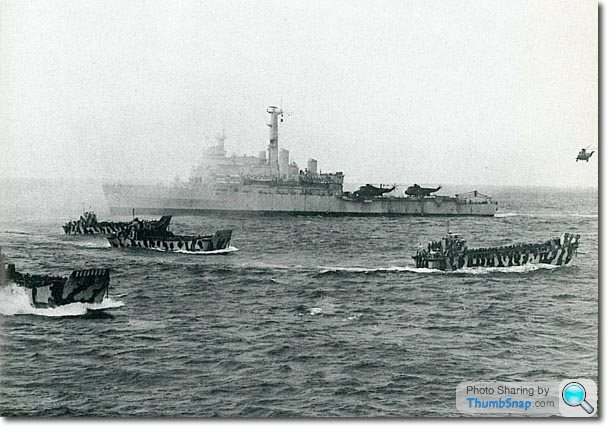
Daybreak. An Argentine Army lieutenant looks out over towards San Carlos from his position, and calls his headquarters to report that he was watching two British ships unloading troops. The Staff were disbelieving, as a pre-war study had determined San Carlos to be unsuitable for a successful landing.
Harriers patrolling to the East discover a hidden helicopter base near Mount Kent, and destroy two Pumas and a Chinook on the ground. 45 minutes later, a Harrier GR3 flown by Flt Lt Jeremy Glover was shot down by ground fire near Port Howard.
Back at San Carlos, two Gazelle scout helicopters are shot down by the Argentinians who had run away from Fanning Head. This was an early indicator that the Gazelle was perhaps not as battleworthy helicopter as hoped.
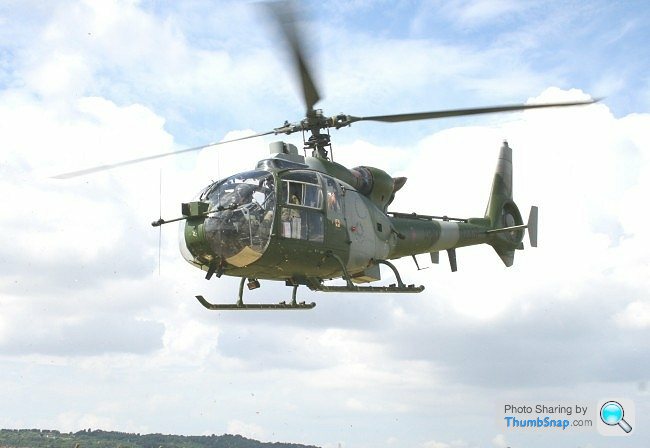
10:00 The Argentine Navy, which had intercepted the Army Lieutenant's signal decides to send a single aircraft over to San Carlos just in case. As he flew West, he saw a British helicopter, and swung over to attack it. As he crossed the final ridge he saw "the entire British fleet," and being a rather game sort, decided to attack it, and picked RFA Fort Austin. All the bombs missed, and the Aermacchi escaped to tell of what he saw arrayed in Falkland Sound.
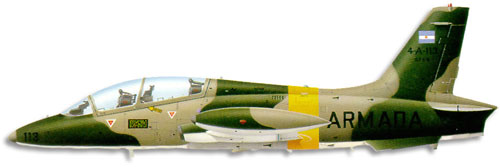
More to come later - I'm working earlies tomorrow.
SD.
All times LOCAL, not ZULU
HMS Ardent enters Falkland Sound. SBS teams are ferried by helicopter to prepare to assault a garrison position on Fanning Head.
01:30. HMS Antrim follows in.
01:45. HMS Fearless, followed by Intrepid enter the sound, by 02:30 they had made the turn to port entering San Carlos Water. The ships wells are flooded, and the landing craft prepared.
02:30. HMS Plymouth escorts Canberra, Stromness, Norland and Fort Austin into the sound, with Brilliant bringing up the rear.
03:50 HMS Antrim announces the British presence in San Carlos by commencing a bombardment of the Fanning Head position with its twin guns. After over 250 rounds were fired, the SBS teams charged in, finding 21 dead or wounded, the survivors had fled.
0600. The five 'Sirs' escorted by Argonaut and Broadsword enter.
07:30. First landing craft beach on San Carlos's water edge. 2 Para just beat 40 Commando to land, but the latter ran up the first flag, in San Carlos Settlement.

Daybreak. An Argentine Army lieutenant looks out over towards San Carlos from his position, and calls his headquarters to report that he was watching two British ships unloading troops. The Staff were disbelieving, as a pre-war study had determined San Carlos to be unsuitable for a successful landing.
Harriers patrolling to the East discover a hidden helicopter base near Mount Kent, and destroy two Pumas and a Chinook on the ground. 45 minutes later, a Harrier GR3 flown by Flt Lt Jeremy Glover was shot down by ground fire near Port Howard.
Back at San Carlos, two Gazelle scout helicopters are shot down by the Argentinians who had run away from Fanning Head. This was an early indicator that the Gazelle was perhaps not as battleworthy helicopter as hoped.

10:00 The Argentine Navy, which had intercepted the Army Lieutenant's signal decides to send a single aircraft over to San Carlos just in case. As he flew West, he saw a British helicopter, and swung over to attack it. As he crossed the final ridge he saw "the entire British fleet," and being a rather game sort, decided to attack it, and picked RFA Fort Austin. All the bombs missed, and the Aermacchi escaped to tell of what he saw arrayed in Falkland Sound.

More to come later - I'm working earlies tomorrow.
SD.
21st May Supplemental.
Two Pucara attack aircraft showed up about five minutes later. One was shot down by a hand-held Stinger missile from the SBS team on Fanning Head, the other was downed by a Sea Cat missile from a ship.

Shortly afterwards, a second Aermacchi turned up, and attacked HMS Argonaut with rockets and gunfire. Three sailors were injured, two seriously, and the big Type 965 radar suffered a large hole. The Aermacchi escaped through two missiles and a barrage of gunfire.
12:35 A formation of three Daggers arrives. Argonaut, Intrepid and Plymouth fire Sea Cats, Plymouth blows one Dagger up.
The second Dagger aims for HMS Broadsword, hitting with 29 30mm shells, but missing with both bombs. Fourteen sailors injured, and both helicopters damaged.
The third Dagger went for Antrim. A thousand-pounder struck the ship, went through the flight deck, bouncing off two big Sea Slug missiles in the magazine, and came to rest in the Head, starting a couple of fires. All the missile systems were knocked out.
12:41. Three more Daggers show up, and make for Antrim, whose crew are jettisoning missiles over the side in case the fires reached them. One got jettisonned by being fired in the general direction of the daggers, albeit unguided. Antrim was reduced to the twin guns in anti-air mode. One Dagger strafed with cannon, injuring seven more sailors and causing more fires. Second Dagger diverted to Fort Austin before being shot down by a Sea Wolf from Broadsword.
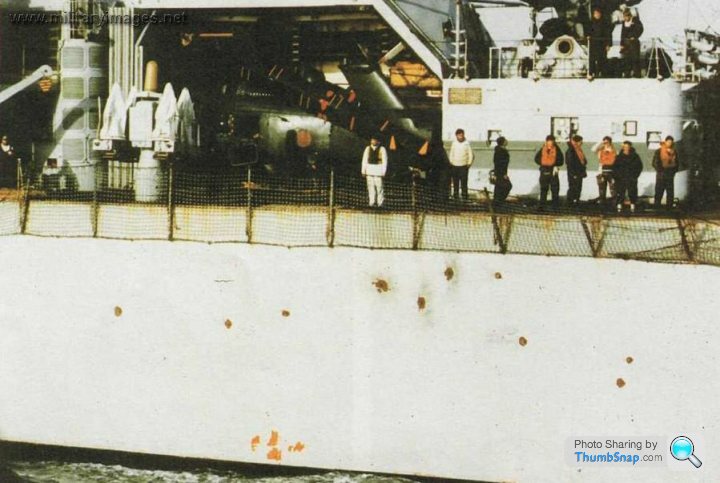
Bullet holes seen on HMS Antrim
The third Dagger now aimed for Broadsword, strafing her, but missing with the bomb.
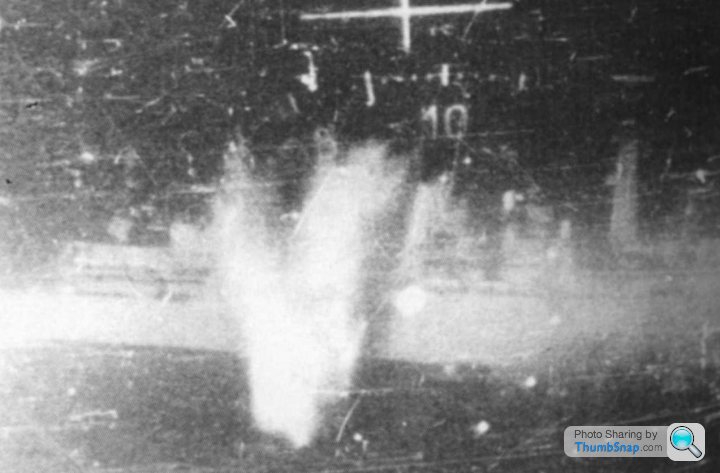
Gun sight image from Argentinean Dagger during strafing run on HMS {i]broadsword[/i]
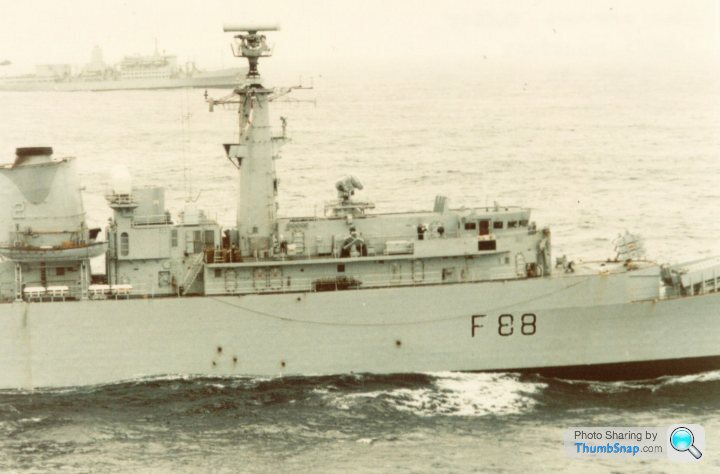
HMS Broadsword showing damage from canon fire.
Antrim was no longer capable of co-ordinating the air defence, and Brilliant took over.
The following radio exchange was made:
Hermes: "Now you be very careful with our aircraft"
Brilliant: "Of course we'll be very careful. Don't worry. We know what we're bloody doing"
Brilliant attempts to direct two Sea Harriers onto the departing two Daggers, but they're too late to catch them.
Ardent blows up a Pucara on the runway at Goose Green with its gun, "Quite by accident" according to her captain. Antrim makes her way to Fearless and is boarded by bomb disposal experts.
13:45. Two more Pucaras arrive on the scene, but are driven off by gunfire and a Sea Cat from Ardent.
14:00 The Pucaras return, heading for Ardent, but Brilliant directs two Sea Harriers onto them. LtCdr Sharky Ward kills one with cannon fire, the pilot ejected and walked back to base. The other escaped.
15:00. Four A-4s arrive, and take a crack at Ardent as well. The bombs all missed, some bouncing over. The aircraft were so low that one hit the ship's radar arial with its belly tank. This wouldn't be the last 'plane-to-ship contact.
As they left, they were chased by two Sea Harriers, two are shot down by missiles.
Incidentally, the senior Naval officer aboard SS Canberra, Cpt Chris Burne, kept a running commentary on proceedings throughout the day on the ship's PA system interspersed with humour which earned him great respect.
16:00. Six A-4s arrive and make for Argonaut. Five made it through the barrage, and dropped ten bombs. Two hit, but neither exploded. (A pattern which was noted by many, including the BBC reporters who advertised this fact on the air. Shortly afterwards, Argentine bombs started exploding more reliably. This would not be the only point of grievance between the Forces and the BBC.)
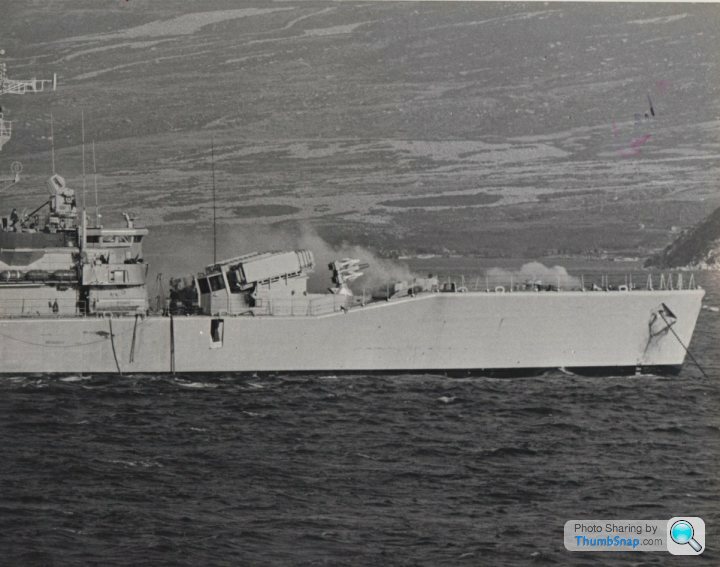
Bomb damage on HMS Argonaut
One bomb punched through the forward fuel tanks before coming to rest in the Sea Cat magazine, and starting a fire and killing two sailors.
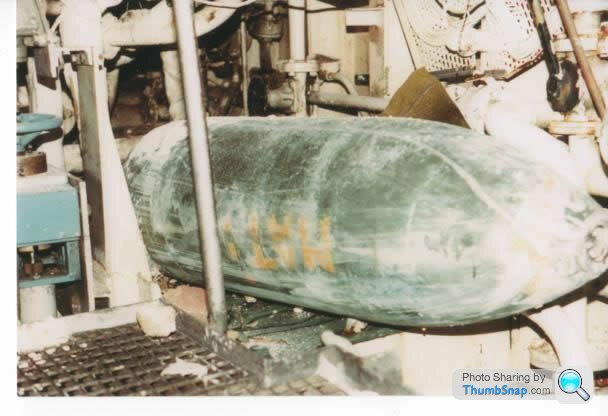
1000lb bomb resting in the SeaCat Magazine
Fuel from the bunkers leaked onto the fire, extinguishing it.
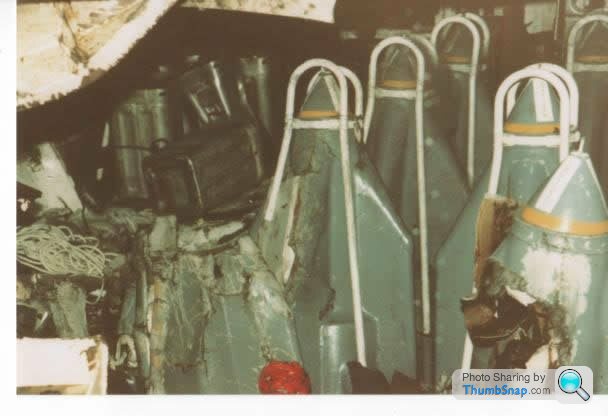
Bomb damage in SeaCat Magazine
The second bomb hit the engine room, wrecking the steering mechanism and reverse gearing.
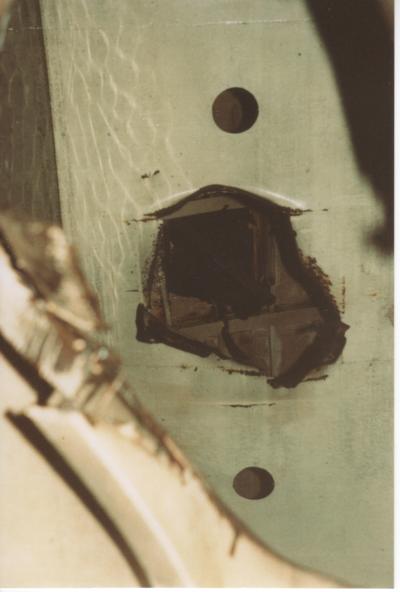
With effectively no brakes, and no steering, the ship was heading towards the rocks at Fanning Head, before a freshly minted Sub-Lieutenant raced off the bridge, grabbed a couple of ratings en route, and dropped the anchor. Shortly afterwards, the ship lost all power.
Four Daggers are next to arrive, but Brilliant directs the Sea Harriers on them, and only three make it to the ships. Intrepid and Plymouth both fire Sea Cats which miss, Fort Austin scores a hit with a machinegun and forces another to abort.
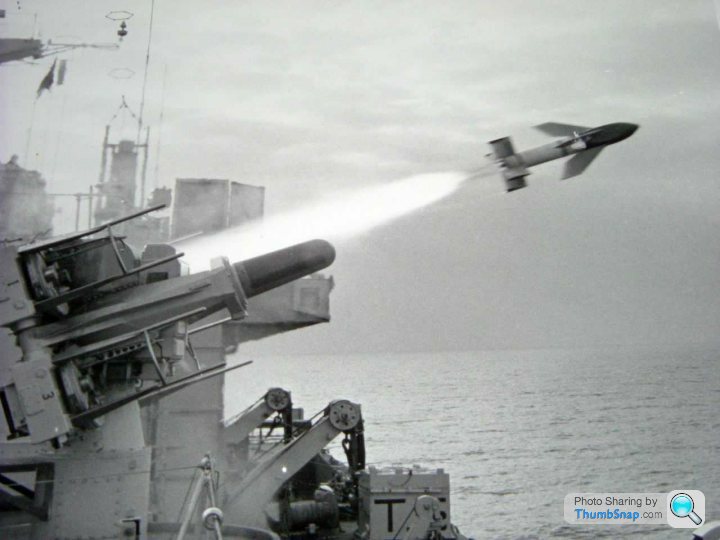
HMS Intrepid firing SeaCat
The remaining two make for Brilliant.
A Sea Wolf fires, but misses, perhaps causing sufficient distraction that the bombs miss. The 30mm cannon does not, and a shot goes right through the Ops room, a splinter entering the back of LtCdr Lee Hulme, who was directing the Sea Harriers. After a brief pause "Just a moment please", and discovering that he could still talk and think, he resumed his duties.
Three Navy Skyhawks came up Falkland Sound, drawing a bead on Ardent, which was sailing North after causing much nuisance with its 4.5" gun on the shore. The gun was out of arc, and the Sea Cat launcher refused to fire. This left just two 20mm cannons and anyone who could man a gun.
The ship's helicopter pilots, Sephton and Murphy, manned the flight deck with a Sterling Submachinegun and a Bren gun. The Navy pilots were some of the best Argentina had, and were good at hitting ships, also they were the only arm to use retarded bombs, which are designed to explode from a low-level release (unlike the air force's bombs). Of nine bombs dropped, two exploded in the hangar, the third penetrated to the auxilliary machine room without exploding. The two pilots and a third man were killed by the blast. The Sea Cat launcher was hurled from the deck and crashed down on top of the ship's supply officer.

A fire broke out in the aft spaces, and she started to flood.
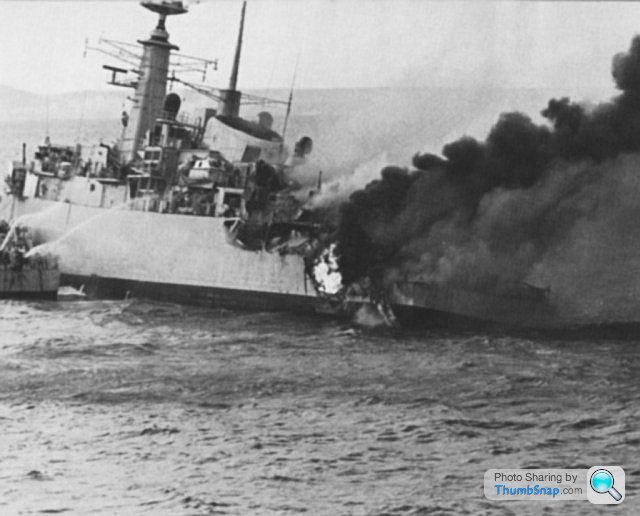
Ardent's doctor who watched the aircraft dodge land and defensive fire later remarked that "We should have figured out that any country which can produce such great Formula 1 drivers could produce good pilots..."
SD.
Two Pucara attack aircraft showed up about five minutes later. One was shot down by a hand-held Stinger missile from the SBS team on Fanning Head, the other was downed by a Sea Cat missile from a ship.

Shortly afterwards, a second Aermacchi turned up, and attacked HMS Argonaut with rockets and gunfire. Three sailors were injured, two seriously, and the big Type 965 radar suffered a large hole. The Aermacchi escaped through two missiles and a barrage of gunfire.
12:35 A formation of three Daggers arrives. Argonaut, Intrepid and Plymouth fire Sea Cats, Plymouth blows one Dagger up.
The second Dagger aims for HMS Broadsword, hitting with 29 30mm shells, but missing with both bombs. Fourteen sailors injured, and both helicopters damaged.
The third Dagger went for Antrim. A thousand-pounder struck the ship, went through the flight deck, bouncing off two big Sea Slug missiles in the magazine, and came to rest in the Head, starting a couple of fires. All the missile systems were knocked out.
12:41. Three more Daggers show up, and make for Antrim, whose crew are jettisoning missiles over the side in case the fires reached them. One got jettisonned by being fired in the general direction of the daggers, albeit unguided. Antrim was reduced to the twin guns in anti-air mode. One Dagger strafed with cannon, injuring seven more sailors and causing more fires. Second Dagger diverted to Fort Austin before being shot down by a Sea Wolf from Broadsword.

Bullet holes seen on HMS Antrim
The third Dagger now aimed for Broadsword, strafing her, but missing with the bomb.

Gun sight image from Argentinean Dagger during strafing run on HMS {i]broadsword[/i]

HMS Broadsword showing damage from canon fire.
Antrim was no longer capable of co-ordinating the air defence, and Brilliant took over.
The following radio exchange was made:
Hermes: "Now you be very careful with our aircraft"
Brilliant: "Of course we'll be very careful. Don't worry. We know what we're bloody doing"
Brilliant attempts to direct two Sea Harriers onto the departing two Daggers, but they're too late to catch them.
Ardent blows up a Pucara on the runway at Goose Green with its gun, "Quite by accident" according to her captain. Antrim makes her way to Fearless and is boarded by bomb disposal experts.
13:45. Two more Pucaras arrive on the scene, but are driven off by gunfire and a Sea Cat from Ardent.
14:00 The Pucaras return, heading for Ardent, but Brilliant directs two Sea Harriers onto them. LtCdr Sharky Ward kills one with cannon fire, the pilot ejected and walked back to base. The other escaped.
15:00. Four A-4s arrive, and take a crack at Ardent as well. The bombs all missed, some bouncing over. The aircraft were so low that one hit the ship's radar arial with its belly tank. This wouldn't be the last 'plane-to-ship contact.
As they left, they were chased by two Sea Harriers, two are shot down by missiles.
Incidentally, the senior Naval officer aboard SS Canberra, Cpt Chris Burne, kept a running commentary on proceedings throughout the day on the ship's PA system interspersed with humour which earned him great respect.
16:00. Six A-4s arrive and make for Argonaut. Five made it through the barrage, and dropped ten bombs. Two hit, but neither exploded. (A pattern which was noted by many, including the BBC reporters who advertised this fact on the air. Shortly afterwards, Argentine bombs started exploding more reliably. This would not be the only point of grievance between the Forces and the BBC.)

Bomb damage on HMS Argonaut
One bomb punched through the forward fuel tanks before coming to rest in the Sea Cat magazine, and starting a fire and killing two sailors.

1000lb bomb resting in the SeaCat Magazine
Fuel from the bunkers leaked onto the fire, extinguishing it.

Bomb damage in SeaCat Magazine
The second bomb hit the engine room, wrecking the steering mechanism and reverse gearing.

With effectively no brakes, and no steering, the ship was heading towards the rocks at Fanning Head, before a freshly minted Sub-Lieutenant raced off the bridge, grabbed a couple of ratings en route, and dropped the anchor. Shortly afterwards, the ship lost all power.
Four Daggers are next to arrive, but Brilliant directs the Sea Harriers on them, and only three make it to the ships. Intrepid and Plymouth both fire Sea Cats which miss, Fort Austin scores a hit with a machinegun and forces another to abort.

HMS Intrepid firing SeaCat
The remaining two make for Brilliant.
A Sea Wolf fires, but misses, perhaps causing sufficient distraction that the bombs miss. The 30mm cannon does not, and a shot goes right through the Ops room, a splinter entering the back of LtCdr Lee Hulme, who was directing the Sea Harriers. After a brief pause "Just a moment please", and discovering that he could still talk and think, he resumed his duties.
Three Navy Skyhawks came up Falkland Sound, drawing a bead on Ardent, which was sailing North after causing much nuisance with its 4.5" gun on the shore. The gun was out of arc, and the Sea Cat launcher refused to fire. This left just two 20mm cannons and anyone who could man a gun.
The ship's helicopter pilots, Sephton and Murphy, manned the flight deck with a Sterling Submachinegun and a Bren gun. The Navy pilots were some of the best Argentina had, and were good at hitting ships, also they were the only arm to use retarded bombs, which are designed to explode from a low-level release (unlike the air force's bombs). Of nine bombs dropped, two exploded in the hangar, the third penetrated to the auxilliary machine room without exploding. The two pilots and a third man were killed by the blast. The Sea Cat launcher was hurled from the deck and crashed down on top of the ship's supply officer.

A fire broke out in the aft spaces, and she started to flood.

Ardent's doctor who watched the aircraft dodge land and defensive fire later remarked that "We should have figured out that any country which can produce such great Formula 1 drivers could produce good pilots..."
SD.
Need a coffee now before more typing!
21st May Supplemental.
Yet another formation of three Daggers arrives, but are met by Harriers piloted by Sharkey Ward and Steve Thomas.
As the Harriers dive onto their targets, they are engaged by small arms fire from Port Howard, which shot down the GR3 earlier. Thomas receives three hits, but continues anyway. All three Daggers are shot down, and the Harriers both return to Invincible.
Still more Skyhawks arrive, and they fall in on Ardent, whose smoke is probably making it easy to find. Maintaining 'Every man with a gun', the ship's civilian NAAFI manager, John Leake, is manning a GPMG, and is credited with a hit on an A-4, whose pilot ejects. Seven bombs hit. Three Skyhawks are shot down by two Sea Harriers as they leave, two by gunfire, one by a missile. Ardent was now suffering 22 dead, 37 wounded, was on fire, and flooding. CDR West orders the ship be abandoned.
Video taken through the SeaWolf tracking camera on HMS Broadsword showing the fire on HMS Ardent
Commander Alan West interview.
HMS Yarmouth puts her stern alongside Ardent's bow, and the ship's remaining company of 142 officers and men simply step across. Cdr West is the last person to leave the ship.
Cdr West became First Sea Lord 2002 - 2006. He was awarded the DSO for his action.
Ardent continued to burn throughout the night, accompanied by the occasional explosion, until she sank the following morning, with only her foremast remaining above the water. Within days navy divers removed her light AA guns for fitting to other ships and her foremast was used as Navigational warning and datum by her sister ship Arrow whilst she bombarded Goose Green. The wreck site is designated as a controlled site under the Protection of Military Remains Act.
Read the Board of Inquiry report into the loss of HMS Ardent.
Five more Skyhawks arrive, but are driven away by fire from Antrim, Intrepid, Plymouth and Fearless. Nobody hits anything.
19:30. Survivors from Ardent cross-deck to Canberra.
Pymouth runs a power line to Argonaut so the latter has power. LtCdr Dutton manages to remove the un-exploded bomb from the missile magazine, making him the most junior officer to ever be awarded a DSO. Argonaut would be unable to steam for the rest of the week, and spend the time sitting in the middle of the bay shooting at anything which happened to fly into range.
Chief Petty Officer Fellows and his UXO team on Antrim cut out a 'tunnel' to lower the bomb into the water and get rid of it that way. He receives a DSC. Welding a four-foot square steel patch on the outside of the ship six feet from the bomb was CMEM Townsend.
Overall, for the loss of fifteen aircraft, the Argentinians had battered one ship to abandonment, two out of the fight for a while, and damage to two others.
On the other hand, there were no casualties to the landing force. To almost everyone's surprise Canberra was totally unscathed, it turned out the Argentine pilots had thought the massive white liner to be a hospital ship and deliberately didn't attack it. Some 4,000 troops were ashore.
Roll of Honour - HMS Ardent.
SD.
Yet another formation of three Daggers arrives, but are met by Harriers piloted by Sharkey Ward and Steve Thomas.
As the Harriers dive onto their targets, they are engaged by small arms fire from Port Howard, which shot down the GR3 earlier. Thomas receives three hits, but continues anyway. All three Daggers are shot down, and the Harriers both return to Invincible.
Still more Skyhawks arrive, and they fall in on Ardent, whose smoke is probably making it easy to find. Maintaining 'Every man with a gun', the ship's civilian NAAFI manager, John Leake, is manning a GPMG, and is credited with a hit on an A-4, whose pilot ejects. Seven bombs hit. Three Skyhawks are shot down by two Sea Harriers as they leave, two by gunfire, one by a missile. Ardent was now suffering 22 dead, 37 wounded, was on fire, and flooding. CDR West orders the ship be abandoned.
Video taken through the SeaWolf tracking camera on HMS Broadsword showing the fire on HMS Ardent
Commander Alan West interview.
HMS Yarmouth puts her stern alongside Ardent's bow, and the ship's remaining company of 142 officers and men simply step across. Cdr West is the last person to leave the ship.
Cdr West became First Sea Lord 2002 - 2006. He was awarded the DSO for his action.
Ardent continued to burn throughout the night, accompanied by the occasional explosion, until she sank the following morning, with only her foremast remaining above the water. Within days navy divers removed her light AA guns for fitting to other ships and her foremast was used as Navigational warning and datum by her sister ship Arrow whilst she bombarded Goose Green. The wreck site is designated as a controlled site under the Protection of Military Remains Act.
Read the Board of Inquiry report into the loss of HMS Ardent.
Five more Skyhawks arrive, but are driven away by fire from Antrim, Intrepid, Plymouth and Fearless. Nobody hits anything.
19:30. Survivors from Ardent cross-deck to Canberra.
Pymouth runs a power line to Argonaut so the latter has power. LtCdr Dutton manages to remove the un-exploded bomb from the missile magazine, making him the most junior officer to ever be awarded a DSO. Argonaut would be unable to steam for the rest of the week, and spend the time sitting in the middle of the bay shooting at anything which happened to fly into range.
Chief Petty Officer Fellows and his UXO team on Antrim cut out a 'tunnel' to lower the bomb into the water and get rid of it that way. He receives a DSC. Welding a four-foot square steel patch on the outside of the ship six feet from the bomb was CMEM Townsend.
Overall, for the loss of fifteen aircraft, the Argentinians had battered one ship to abandonment, two out of the fight for a while, and damage to two others.
On the other hand, there were no casualties to the landing force. To almost everyone's surprise Canberra was totally unscathed, it turned out the Argentine pilots had thought the massive white liner to be a hospital ship and deliberately didn't attack it. Some 4,000 troops were ashore.
Roll of Honour - HMS Ardent.
- Able Seaman Derek D. Armstrong
- Lieutenant Commander Richard W. Banfield
- Able Seaman Andrew R. Barr
- Petty Officer Peter Brouard
- Cook Richard S. J. Dunkerley
- Leading Cook Michael P. Foote
- Marine Engineering Mechanic Stephen H. Ford
- Acting Steward Shaun Hanson
- Able Seaman Shaun K. Hayward
- Able Seaman Stephen Heyes
- Weapons Engineering Mechanic Simon J. Lawson
- Marine Engineering Mechanic Alistair R. Leighton
- Air Engineering Mechanician Allan McAuley
- Acting Leading Seaman Michael S. Mullen
- Lieutenant Brian Murphy
- Leading Physical Training Instructor Gary T. Nelson
- Cook John R. Roberts
- Lieutenant Commander John M. Sephton
- Leading Marine Engineering Mechanic Stephen J. White
- Leading Marine Engineering Mechanic Garry Whitford
- Petty Officer Weapons Engineering Mechanician Andrew K. Palmer
- Marine Engineering Mechanic Gilbert S. Williams
SD.
Edited by shed driver on Sunday 21st May 20:46
Nuclear weapons were taken on Op. Corporate - there was as far as I know no discussion or thought of using them, but how to store them in the event that ships carrying them were lost.
Report into the Carriage of Nuclear Weapons by the Task Force.
22nd May
An Argentine Air Force Boeing 707 on a reconnaissance mission avoided being hit by HMS Coventry's Sea Dart as a flash-door failed safe, preventing missile loading on the launcher.
A second 707 approached the Bristol Group later in the morning. Tidespring had reported the aircraft's presence and HMS Cardiff dropped back from the group. When the 707 came within her range, Cardiff fired a Sea Dart salvo. One missile was seen to burst close to the target which broke away.
HMS Broadsword joined Coventry on the missile trap station off Pebble Island, having watched Ardent's fires spread during the night.
07:00HMS Ardent sinks.
HMS Brilliant returned to San Carlos Water.
HMS Yarmouth guarded the entrance to San Carlos Water along with HMS Argonaut.
A strong CAP was maintained, with sixty sorties flying from the carriers. Bad weather on the mainland prevented the Argentine Air Force launching any strikes.
Coast Guard patrol boat Rio Iguazu was strafed by an 801 Squadron CAP in Choiseul Sound. The boat was driven ashore among the kelp.
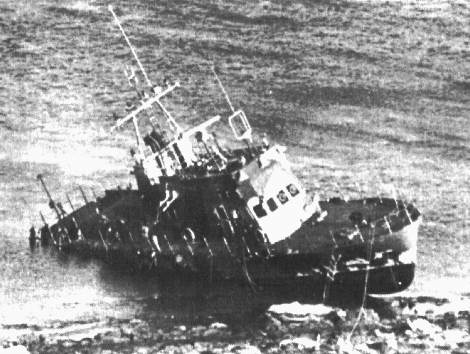
Rio Igauzu seen beached near Choiseul Sound.
Goose Green was attacked by four GR3s, causing damage to the fuel dump with cluster bombs. Later in the day Coventry and Broadsword parted company.
Coventry returned to San Carlos Water and Broadsword headed to rejoin the Carrier Battle Group. HMS Exeter arrived and took her place on the picket line.
HMS Brillant and Yarmouth transited south. Shortly before midnight a Lynx was flown to investigate a radar contact made in Lively Sound. The vessel was identified as the coaster Monsunnen. The crew ran the ship aground among the kelp and escaped over the rocks.
Field Hospital established at Ajax Bay. Rick Jolly was a massive hero of mine - more to come about the field hospital as it happens.
SD.
Report into the Carriage of Nuclear Weapons by the Task Force.
22nd May
An Argentine Air Force Boeing 707 on a reconnaissance mission avoided being hit by HMS Coventry's Sea Dart as a flash-door failed safe, preventing missile loading on the launcher.
A second 707 approached the Bristol Group later in the morning. Tidespring had reported the aircraft's presence and HMS Cardiff dropped back from the group. When the 707 came within her range, Cardiff fired a Sea Dart salvo. One missile was seen to burst close to the target which broke away.
HMS Broadsword joined Coventry on the missile trap station off Pebble Island, having watched Ardent's fires spread during the night.
07:00HMS Ardent sinks.
HMS Brilliant returned to San Carlos Water.
HMS Yarmouth guarded the entrance to San Carlos Water along with HMS Argonaut.
A strong CAP was maintained, with sixty sorties flying from the carriers. Bad weather on the mainland prevented the Argentine Air Force launching any strikes.
Coast Guard patrol boat Rio Iguazu was strafed by an 801 Squadron CAP in Choiseul Sound. The boat was driven ashore among the kelp.

Rio Igauzu seen beached near Choiseul Sound.
Goose Green was attacked by four GR3s, causing damage to the fuel dump with cluster bombs. Later in the day Coventry and Broadsword parted company.
Coventry returned to San Carlos Water and Broadsword headed to rejoin the Carrier Battle Group. HMS Exeter arrived and took her place on the picket line.
HMS Brillant and Yarmouth transited south. Shortly before midnight a Lynx was flown to investigate a radar contact made in Lively Sound. The vessel was identified as the coaster Monsunnen. The crew ran the ship aground among the kelp and escaped over the rocks.
Field Hospital established at Ajax Bay. Rick Jolly was a massive hero of mine - more to come about the field hospital as it happens.
SD.
23rd May
HMS Brilliant had joined the Carrier Battle Group during the night, HMS [/i]Antelope[/i] replaced her at San Carlos, bringing with her the first re-supply convoy made up of the Stromness, Norland and Europic Ferry.
The ships had spent the day before, along with Elk and RFA Resource on the edge of the TEZ, transferring hundreds of loads.
Sea Harrier from Hermes spots a wandering Argentine patrol craft in Choiseul Sound, strafes it, and forces it to run aground.
More Harriers find another helicopter facility, destroying three Pumas and an A109.
Two C-130s escorted by six Mirages make a run to West Falkland, and the British prove unable to intercept them.
16:00 Four Skyhawks show up, and track in on Broadsword and Antelope.
A thousand-pounder lands on the starboard quarter. This pilot was a little too low, and hits Antelope's mast, breaking it. As he struggles to recover, he is blown out of the sky by a Sea Wolf from Broadsword.
Another bomb enters low on the port side, under the bridge. Again, it fails to explode, but in its path to the Petty Officer's Mess, it kills a steward, Mark Stevens and injures two sick berth attendants.
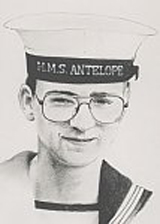
Steward Mark R Stevens - HMS Antelope
Eight more Skyhawks arrive, attacking Yarmouth, Antelope and Broadsword. After much shooting and dropping of bombs, nobody hit anything.
18:00. Three Daggers make a crack at it, one is shot down by a Sea Harrier. No other damage.
20:15. While Staff Sergeant Prescott and Warrant Officer Phillips of the Royal Engineers attempt to defuse one of Antelope's bombs, it detonates, killing Prescott and removing one of Phillips' arms. This also starts a fire.
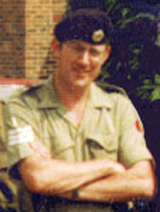
Staff Sergeant James Prescott CGM
Read James Prescott's London Gazette Citation.
With fire on all three decks, fanned by the wind, and the fire main broken, nothing for it but to abandon ship.
Eventually the fire reaches the missile magazine.
SD.
HMS Brilliant had joined the Carrier Battle Group during the night, HMS [/i]Antelope[/i] replaced her at San Carlos, bringing with her the first re-supply convoy made up of the Stromness, Norland and Europic Ferry.
The ships had spent the day before, along with Elk and RFA Resource on the edge of the TEZ, transferring hundreds of loads.
Sea Harrier from Hermes spots a wandering Argentine patrol craft in Choiseul Sound, strafes it, and forces it to run aground.
More Harriers find another helicopter facility, destroying three Pumas and an A109.
Two C-130s escorted by six Mirages make a run to West Falkland, and the British prove unable to intercept them.
16:00 Four Skyhawks show up, and track in on Broadsword and Antelope.
A thousand-pounder lands on the starboard quarter. This pilot was a little too low, and hits Antelope's mast, breaking it. As he struggles to recover, he is blown out of the sky by a Sea Wolf from Broadsword.
Another bomb enters low on the port side, under the bridge. Again, it fails to explode, but in its path to the Petty Officer's Mess, it kills a steward, Mark Stevens and injures two sick berth attendants.

Steward Mark R Stevens - HMS Antelope
Eight more Skyhawks arrive, attacking Yarmouth, Antelope and Broadsword. After much shooting and dropping of bombs, nobody hit anything.
18:00. Three Daggers make a crack at it, one is shot down by a Sea Harrier. No other damage.
20:15. While Staff Sergeant Prescott and Warrant Officer Phillips of the Royal Engineers attempt to defuse one of Antelope's bombs, it detonates, killing Prescott and removing one of Phillips' arms. This also starts a fire.

Staff Sergeant James Prescott CGM
Read James Prescott's London Gazette Citation.
With fire on all three decks, fanned by the wind, and the fire main broken, nothing for it but to abandon ship.
Eventually the fire reaches the missile magazine.
SD.
HMS Antelope. 23rd May
HMS Antelope (F170) was a Type 21 frigate. Her keel was laid down March 23, 1971 by Vosper Thornycroft in Woolston. She was commissioned July 17, 1975. She was the only unit of the class never to be fitted with Exocet launchers.
The San Carlos frigates launched strikes, Argonaut's Lynx attempted a Sea Skua missile attack on the Rio Carcarana but was thwarted by technical problems. Antelope's flight then attacked the same target, firing two Sea Skuas, both of which hit the ship. The unloading of the stores ship was carried out with little interruption. The Stromness had brought equipment intended for assembly as GR3 landing pads which the Royal Engineers wasted no time in putting it together. The bridgehead was consolidated with 5,000 troops dug in.
HMS Antelope flew off her Lynx to investigate the extent of damage inflicted on the Rio Carcarana. As the Lynx returned it was overflown by four Skyhawks and the pilot broadcast a warning of the raid. Consequently, Broadsword, Antelope and Yarmouth were ready and the first pair of Skyhawks were turned back.
The second pair selected Antelope and Broadsword, Premier Teniente L Guadagnini pressed home his attack on the Antelope despite being hit by 20mm fire and scored a direct hit about six feet above the water line on the starboard side of the frigate, below the hangar.
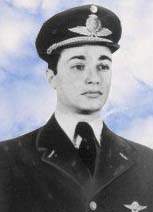
Premier Teniente L Guadagnini
The Skyhawk collided with the main mast, blew up and fell into the water.
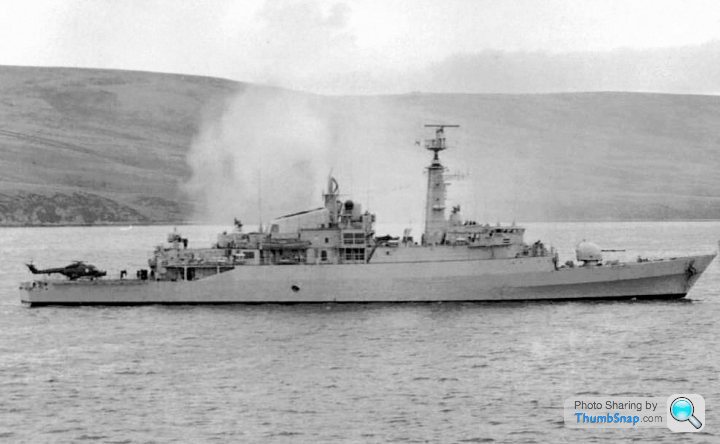
HMS Antelope following the A4 attack showing damage to the main mast, entry hole from bomb clearly seen
Another Skyhawk attacked unnoticed from Antelope's port and put another bomb into her port side. Both bombs had failed to exploded, one was in Antelope's Air Conditioning Unit and the second in her Petty Officers Mess. Antelope lost one man, Steward Mark R. Stephens with others injured.
Later in the day the Antelope moved up San Carlos Water near Fearless. The casualty was moved to the field hospital and two Royal Engineers bomb disposal experts came on board. The first attempts to defuse the bomb were unsuccessful. The men decided to use a small defusing charge. As they walked back to examine the results, the bomb exploded and Staff Sargent Prescott was killed instantly, Warrant Officer Phillips left arm was badly injured. Staff Sergeant Prescott was awarded a posthumous Conspicuous Gallantry Medal.
The ship was torn open from water line to funnel, with the blast starting major fires in both engine rooms which spread very quickly. The starboard fire main was fractured, the ship lost all electrical power, and the commanding officer, Commander Nick Tobin, gave the order to abandon ship. Tobin was the last person to leave the ship, and about five minutes after his departure, the missile magazines began exploding. The explosion started a number of fires, as she burned the ship blazed white hot and was abandoned by her 175 crew.
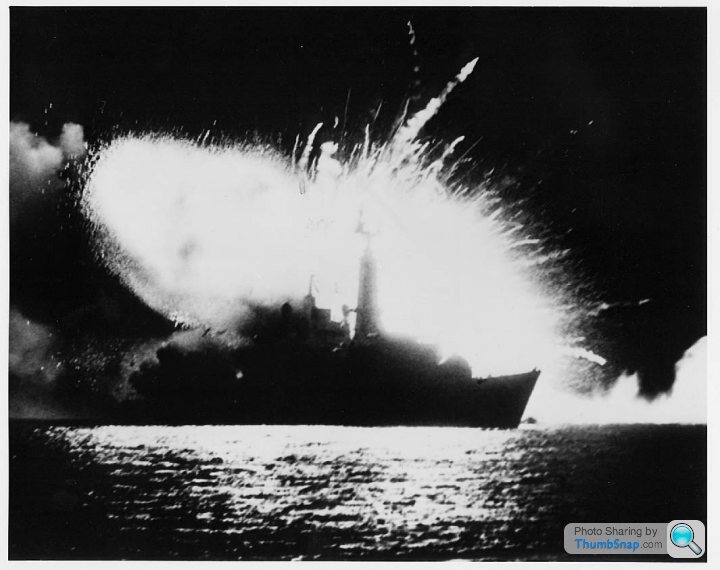
Fires reach the magazines on HMS Antelope
Explosions continued throughout the night, and the following day Antelope was found to be still afloat, but her keel had broken and her superstructure melted into a heap of twisted metal. Antelope broke in half and sank on May 24th 1982.
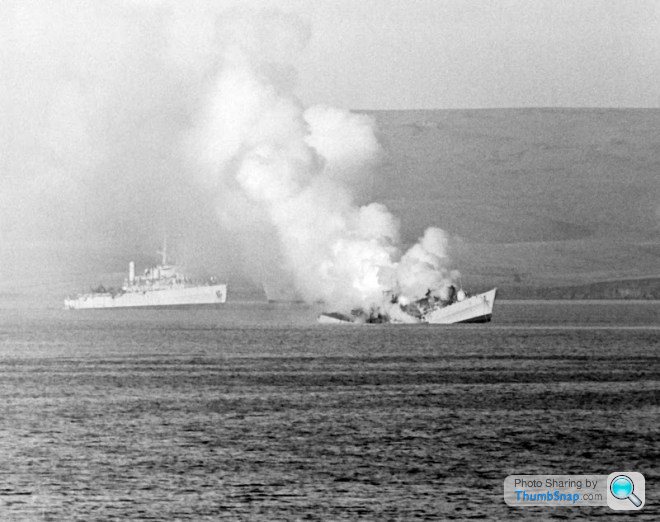
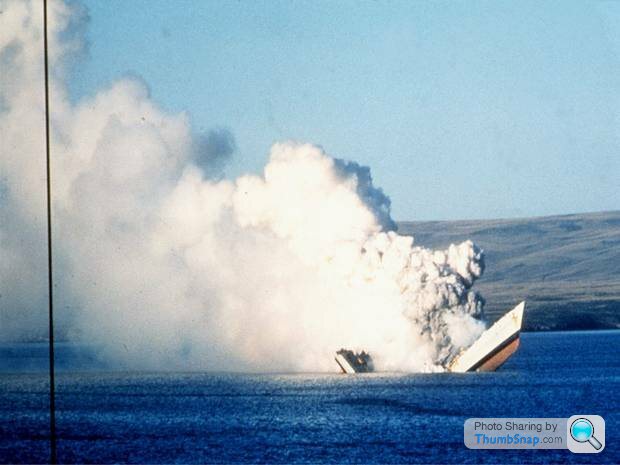
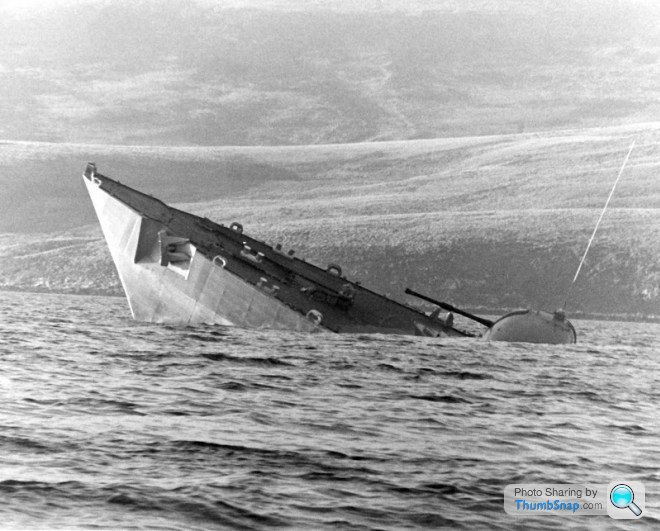
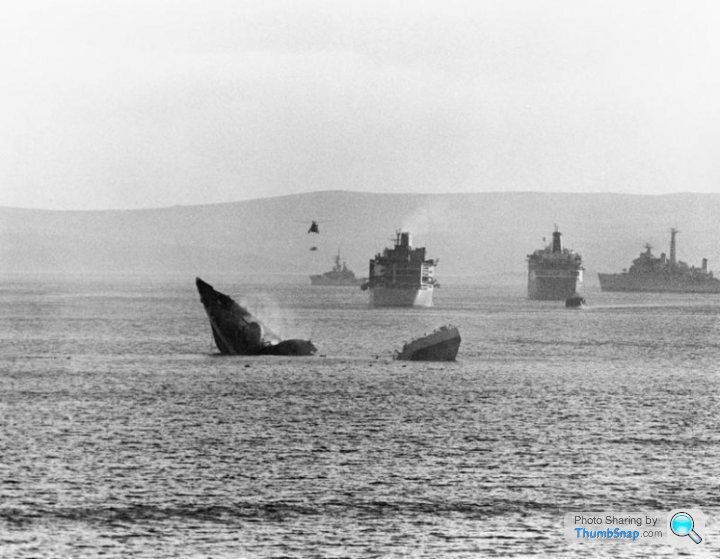
Read the Board of Inquiry report into the loss of HMS Antelope.
SD.
HMS Antelope (F170) was a Type 21 frigate. Her keel was laid down March 23, 1971 by Vosper Thornycroft in Woolston. She was commissioned July 17, 1975. She was the only unit of the class never to be fitted with Exocet launchers.
The San Carlos frigates launched strikes, Argonaut's Lynx attempted a Sea Skua missile attack on the Rio Carcarana but was thwarted by technical problems. Antelope's flight then attacked the same target, firing two Sea Skuas, both of which hit the ship. The unloading of the stores ship was carried out with little interruption. The Stromness had brought equipment intended for assembly as GR3 landing pads which the Royal Engineers wasted no time in putting it together. The bridgehead was consolidated with 5,000 troops dug in.
HMS Antelope flew off her Lynx to investigate the extent of damage inflicted on the Rio Carcarana. As the Lynx returned it was overflown by four Skyhawks and the pilot broadcast a warning of the raid. Consequently, Broadsword, Antelope and Yarmouth were ready and the first pair of Skyhawks were turned back.
The second pair selected Antelope and Broadsword, Premier Teniente L Guadagnini pressed home his attack on the Antelope despite being hit by 20mm fire and scored a direct hit about six feet above the water line on the starboard side of the frigate, below the hangar.

Premier Teniente L Guadagnini
The Skyhawk collided with the main mast, blew up and fell into the water.

HMS Antelope following the A4 attack showing damage to the main mast, entry hole from bomb clearly seen
Another Skyhawk attacked unnoticed from Antelope's port and put another bomb into her port side. Both bombs had failed to exploded, one was in Antelope's Air Conditioning Unit and the second in her Petty Officers Mess. Antelope lost one man, Steward Mark R. Stephens with others injured.
Later in the day the Antelope moved up San Carlos Water near Fearless. The casualty was moved to the field hospital and two Royal Engineers bomb disposal experts came on board. The first attempts to defuse the bomb were unsuccessful. The men decided to use a small defusing charge. As they walked back to examine the results, the bomb exploded and Staff Sargent Prescott was killed instantly, Warrant Officer Phillips left arm was badly injured. Staff Sergeant Prescott was awarded a posthumous Conspicuous Gallantry Medal.
The ship was torn open from water line to funnel, with the blast starting major fires in both engine rooms which spread very quickly. The starboard fire main was fractured, the ship lost all electrical power, and the commanding officer, Commander Nick Tobin, gave the order to abandon ship. Tobin was the last person to leave the ship, and about five minutes after his departure, the missile magazines began exploding. The explosion started a number of fires, as she burned the ship blazed white hot and was abandoned by her 175 crew.

Fires reach the magazines on HMS Antelope
Explosions continued throughout the night, and the following day Antelope was found to be still afloat, but her keel had broken and her superstructure melted into a heap of twisted metal. Antelope broke in half and sank on May 24th 1982.




Read the Board of Inquiry report into the loss of HMS Antelope.
SD.
24th May
Eight EEC nations vote to continue trade boycott of Argentina.
The fires on HMS Antelope continue to burn through the night. Shortly after dawn another major explosion occurs, the ship's back breaks and she sinks with her bows and stern sticking out of the water. Her survivors are transferred to the Norland during the day.
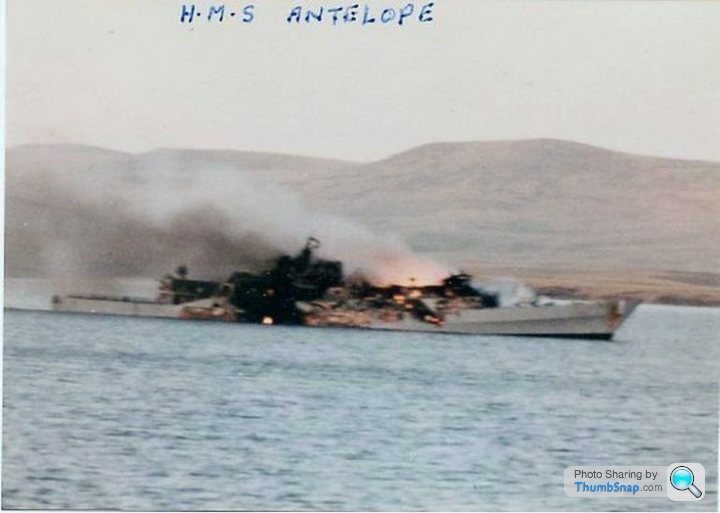
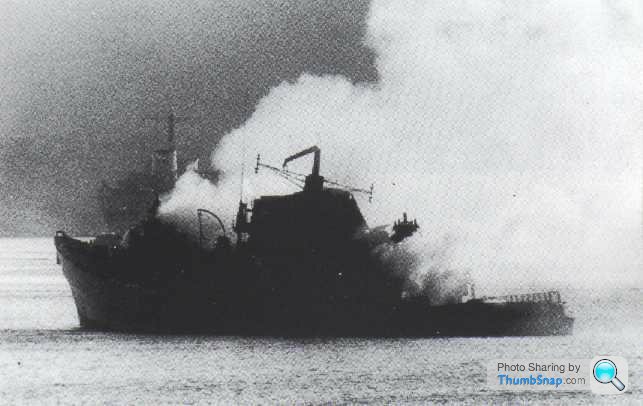
HMS Antelope continues to burn - note the main mast broken when hit by an attacking A4.
The morning is clear in San Carlos Water and loading continued.
HMS Coventry and Broadsword take up a 'missile trap' station off Pebble Island.
The Argentine Air Force Commanders change their patterns of approach which allows them to benefit from the surrounding terrain
.
The first wave of A-4Bs scores three direct hits on the Sir Galahad, Sir Lancelot and Sir Bedivere which are positioned off Ajax Bay and near-misses Fort Austin.
Sir Galahad and Sir Lancelot have been hit by two 1,000lb bombs which have failed to explode, but started fires and the Sir Bedivere by a bomb which glanced off the crane forward of the bridge, through a bulwark and on into the sea where it explodes.
A wave of Daggers follows but the ships are now alert to the danger and engage the aircraft with Seacat, Rapier and automatic weapons.
The Daggers strafe HMS Fearless and the Sir Galahad and another bomb hits Sir Lancelot but once again this fails to explode.
Another Dagger division has been tracked by HMS Coventry and [/i]Broadsword[/i] and a Sea Harrier CAP has been vectored to intercept. Three of the Daggers were shot down with Teniente C. J. Castillo losing his life.
Three A-4Cs make an attack on San Carlos Water at about the same time. They too run into fierce gun and missile fire.
The weather deteriorates in the afternoon giving the ships their first natural cover.
The fires on Sir Galahad and Sir Lancelot have been put out and Sir Galahad's bomb is removed during the night. Sir Lancelot's proves more difficult and has to be cut free before it can be removed.
The Carrier Battle Group launches additional aircraft on CAP to guard against any possible dusk strikes.
Two Skyhawks make a run at 40 Commando's position in San Carlos Settlement. Parachute-retarded bombs fell on target, but the combination of entrenchments and soft peat resulted in only two fatalities, and three wounded.
More successful was a three-Skyhawk raid on the Brigade Maintainance Area, killing six, wounding 27 and starting a fire in 45 Commando's main ammunition dump with 12 bombs. The initial plan had been for the British to keep their main logistical assets afloat. The attacks of the previous days had caused them to reconsider their strategy as supplies aren't much use on a sunken ship, and set up land bases instead. Now one of them was exploding throughout the night.
By now San Carlos Water had been christened Bomb Alley by the British, and Death Valley by the Argentinians. There is still much speculation as to what would have happened had the Argentinians used their Mirage III fighters to escort the bombers in, as most of the kills were scored by Harriers in air combat. Instead, they were kept in defence of the Argentine Mainland: The Black Buck Vulcan bombing raids had put them in fear of raids on their mainland bases, or worse, Buenos Aires.
The submarine ARA San Luis, having a couple of days previously given up on the concept of trying to sink British ships with equipment that doesn't want to work, puts into port in Argentina in an attempt to repair. She will take no further part in the war.
In the meantime, the land forces remain dug in in their positions in the hills around San Carlos. They do some local patrolling, and expend prodigious ammunition at the aircraft flying overhead (to the dismay of the supply types), but frustration was building up both amongst the men, who were keen to get on with things, and the Royal Navy, which was taking a pasting, while the Army/Marines were just sitting there.
In actuality, the land forces were not yet in a position to move forward, they simply didn't have all the required supplies ready.
Sd.
Eight EEC nations vote to continue trade boycott of Argentina.
The fires on HMS Antelope continue to burn through the night. Shortly after dawn another major explosion occurs, the ship's back breaks and she sinks with her bows and stern sticking out of the water. Her survivors are transferred to the Norland during the day.


HMS Antelope continues to burn - note the main mast broken when hit by an attacking A4.
The morning is clear in San Carlos Water and loading continued.
HMS Coventry and Broadsword take up a 'missile trap' station off Pebble Island.
The Argentine Air Force Commanders change their patterns of approach which allows them to benefit from the surrounding terrain
.
The first wave of A-4Bs scores three direct hits on the Sir Galahad, Sir Lancelot and Sir Bedivere which are positioned off Ajax Bay and near-misses Fort Austin.
Sir Galahad and Sir Lancelot have been hit by two 1,000lb bombs which have failed to explode, but started fires and the Sir Bedivere by a bomb which glanced off the crane forward of the bridge, through a bulwark and on into the sea where it explodes.
A wave of Daggers follows but the ships are now alert to the danger and engage the aircraft with Seacat, Rapier and automatic weapons.
The Daggers strafe HMS Fearless and the Sir Galahad and another bomb hits Sir Lancelot but once again this fails to explode.
Another Dagger division has been tracked by HMS Coventry and [/i]Broadsword[/i] and a Sea Harrier CAP has been vectored to intercept. Three of the Daggers were shot down with Teniente C. J. Castillo losing his life.
Three A-4Cs make an attack on San Carlos Water at about the same time. They too run into fierce gun and missile fire.
The weather deteriorates in the afternoon giving the ships their first natural cover.
The fires on Sir Galahad and Sir Lancelot have been put out and Sir Galahad's bomb is removed during the night. Sir Lancelot's proves more difficult and has to be cut free before it can be removed.
The Carrier Battle Group launches additional aircraft on CAP to guard against any possible dusk strikes.
Two Skyhawks make a run at 40 Commando's position in San Carlos Settlement. Parachute-retarded bombs fell on target, but the combination of entrenchments and soft peat resulted in only two fatalities, and three wounded.
More successful was a three-Skyhawk raid on the Brigade Maintainance Area, killing six, wounding 27 and starting a fire in 45 Commando's main ammunition dump with 12 bombs. The initial plan had been for the British to keep their main logistical assets afloat. The attacks of the previous days had caused them to reconsider their strategy as supplies aren't much use on a sunken ship, and set up land bases instead. Now one of them was exploding throughout the night.
By now San Carlos Water had been christened Bomb Alley by the British, and Death Valley by the Argentinians. There is still much speculation as to what would have happened had the Argentinians used their Mirage III fighters to escort the bombers in, as most of the kills were scored by Harriers in air combat. Instead, they were kept in defence of the Argentine Mainland: The Black Buck Vulcan bombing raids had put them in fear of raids on their mainland bases, or worse, Buenos Aires.
The submarine ARA San Luis, having a couple of days previously given up on the concept of trying to sink British ships with equipment that doesn't want to work, puts into port in Argentina in an attempt to repair. She will take no further part in the war.
In the meantime, the land forces remain dug in in their positions in the hills around San Carlos. They do some local patrolling, and expend prodigious ammunition at the aircraft flying overhead (to the dismay of the supply types), but frustration was building up both amongst the men, who were keen to get on with things, and the Royal Navy, which was taking a pasting, while the Army/Marines were just sitting there.
In actuality, the land forces were not yet in a position to move forward, they simply didn't have all the required supplies ready.
Sd.
SkinnyPete said:
From reading this it appears almost every Argentine aircraft that attacks gets shot down, was it really like shooting fish in a barrel? I am assuming every downing guarantees the pilot is also killed.
It also appears that their bombs are incredibly unreliable, even the Exocet that hit the Sheffield didn't explode. Why are they so unreliable?
The Argentine Air Force and Naval Air Arm numbered about 240 - not all useable, and many remained on the mainland to guard against possible Chilean aggression.It also appears that their bombs are incredibly unreliable, even the Exocet that hit the Sheffield didn't explode. Why are they so unreliable?
A lot of the bombs were fitted with fuses which did not arm due to the low level they were released at - the BBC reported the number of unexploded bombs - the Argentines altered the fusing with devestating effect.
SD.
25th May
Argentina’s National Day dawns. Its significance is not lost on the Task Force.
UN Security Council debate ended.
HMS Glasgow finally gives up trying to fight the fight, and departs for the UK.
HMS Bristol, a 7,000 ton Type 82 destroyer, leads a group of ships as they arrive in the Task Force's Area of Operations. The sole ship built of a class of four planned, it lost its purpose when the Queen Elizabeth class of aircraft carriers it was supposed to escort was cancelled in 1966. It's a cruiser in all but name.
With it are HMS Cardiff, another Type 42, Penelope and Minerva, Leanders like Argonaut, HMS Andromeda, a Sea Wolf Leander, and HMS Active and Avenger, both Type 21s. To quote Woodward "From where I sat, they were more than welcome, since at this stage we were losing warships at a fairly high rate"
Two tankers also show up, Olna and Bayleaf, and a sister ship to Fort Austin, Fort Grange.
11:30 A formation of Daggers is detected on the run-in to Falkland Sound by Coventry, which in company of Broadsword, constituted the “Type 64” frigate.
One is shot down by a Sea Dart missile, the others conduct their run, but miss.
14:30 – approx.. Four A-4s looping around over East Falkland come at the fleet, and come within range of Yarmouth. Their SeaCat kills one, the other three aircraft don't hit anything.
On the way out, they come into range of Coventry, whose Sea Dart gets another kill.
The destroyer intercepts a signal, and takes it as a bit of a complement that the Argentinians thought it would take six Skyhawks to 'Get that Type-42 out there'
17:00. Six Skyhawks of 5th Air Brigade launch, but due to problems refuelling, only four continued to the attack. Flying a little higher than normal, to save fuel for the attack run, they were picked up early by the British, about a hundred miles out. Harriers were sent to intercept, but the Argentinians split into pairs, and went low. By the time they showed up again, it was too late to vector the Harriers in.
When they appeared again, they were too low for Coventry's long-distance radar to pick them out. The first pair made for Broadsword, whose radar was much more suited to close-range work.
Unfortunately, the two A-4s were so close together that Broadsword's system couldn't quite figure out if it was trying to engage one target or two, decided it wasn't worth what it was being paid to try to figure it out, and switched itself off. Early Type 22s have no main gun, so it's down to autocannon, machineguns and rifle fire.
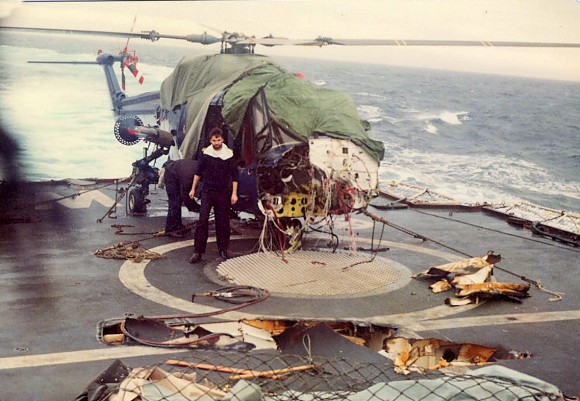
Of the four thousand-pound bombs, only one struck the ship after bouncing off the sea, entering starboard aft without exploding, punching out to the flight deck, through the helicopter (Destroying it, of course), and into the sea.
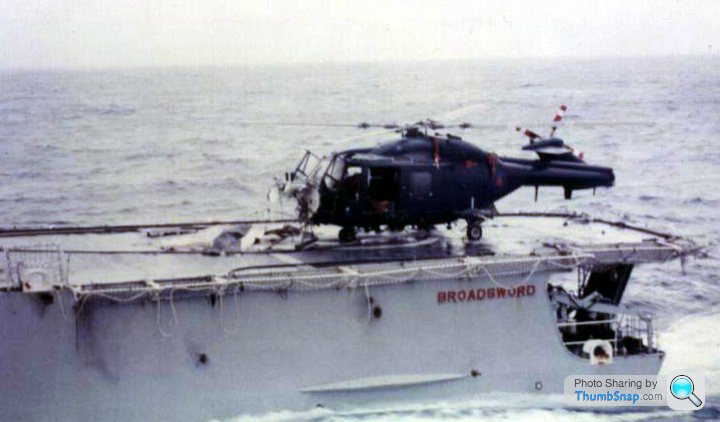
More when I finish work at 21:00.
SD.
Argentina’s National Day dawns. Its significance is not lost on the Task Force.
UN Security Council debate ended.
HMS Glasgow finally gives up trying to fight the fight, and departs for the UK.
HMS Bristol, a 7,000 ton Type 82 destroyer, leads a group of ships as they arrive in the Task Force's Area of Operations. The sole ship built of a class of four planned, it lost its purpose when the Queen Elizabeth class of aircraft carriers it was supposed to escort was cancelled in 1966. It's a cruiser in all but name.
With it are HMS Cardiff, another Type 42, Penelope and Minerva, Leanders like Argonaut, HMS Andromeda, a Sea Wolf Leander, and HMS Active and Avenger, both Type 21s. To quote Woodward "From where I sat, they were more than welcome, since at this stage we were losing warships at a fairly high rate"
Two tankers also show up, Olna and Bayleaf, and a sister ship to Fort Austin, Fort Grange.
11:30 A formation of Daggers is detected on the run-in to Falkland Sound by Coventry, which in company of Broadsword, constituted the “Type 64” frigate.
One is shot down by a Sea Dart missile, the others conduct their run, but miss.
14:30 – approx.. Four A-4s looping around over East Falkland come at the fleet, and come within range of Yarmouth. Their SeaCat kills one, the other three aircraft don't hit anything.
On the way out, they come into range of Coventry, whose Sea Dart gets another kill.
The destroyer intercepts a signal, and takes it as a bit of a complement that the Argentinians thought it would take six Skyhawks to 'Get that Type-42 out there'
17:00. Six Skyhawks of 5th Air Brigade launch, but due to problems refuelling, only four continued to the attack. Flying a little higher than normal, to save fuel for the attack run, they were picked up early by the British, about a hundred miles out. Harriers were sent to intercept, but the Argentinians split into pairs, and went low. By the time they showed up again, it was too late to vector the Harriers in.
When they appeared again, they were too low for Coventry's long-distance radar to pick them out. The first pair made for Broadsword, whose radar was much more suited to close-range work.
Unfortunately, the two A-4s were so close together that Broadsword's system couldn't quite figure out if it was trying to engage one target or two, decided it wasn't worth what it was being paid to try to figure it out, and switched itself off. Early Type 22s have no main gun, so it's down to autocannon, machineguns and rifle fire.

Of the four thousand-pound bombs, only one struck the ship after bouncing off the sea, entering starboard aft without exploding, punching out to the flight deck, through the helicopter (Destroying it, of course), and into the sea.

More when I finish work at 21:00.
SD.
25th May Supplemental
The loss of HMS Coventry
In the meantime, the other Skyhawk pair was aiming for Coventry. Again, the Sea Dart/Type 909 combo failed to lock, so the main gun was being fired optically, and everyone who had a personal weapon was banging merrily away.

Over on Broadsword, the air warfare crowd got the Sea Wolf system functioning again, and a proper lock. At the last second, however, Coventry, trying to manoeuvre to get a clear lock with the radar, crossed in front of Broadsword, masking her. The frigate couldn't shoot.
One bomb fell astern, the other three entered the port side and all exploded. Nineteen were killed instantly.
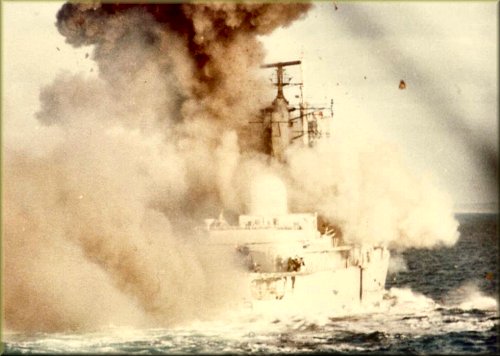
No order to abandon ship was given. Coventry indicated her intention to sink by capsizing early on, and it was un-necessary to incite people to get off.
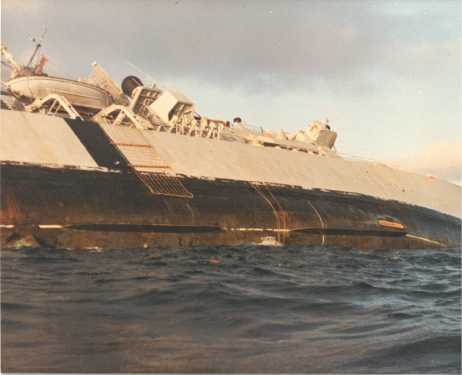
The Cross of Nails went to the bottom of the sea with her.
All of Woodward's initial three air defence destroyers were now gone. After the war, divers were sent to the wreckage to retrieve the Cross of Nails.
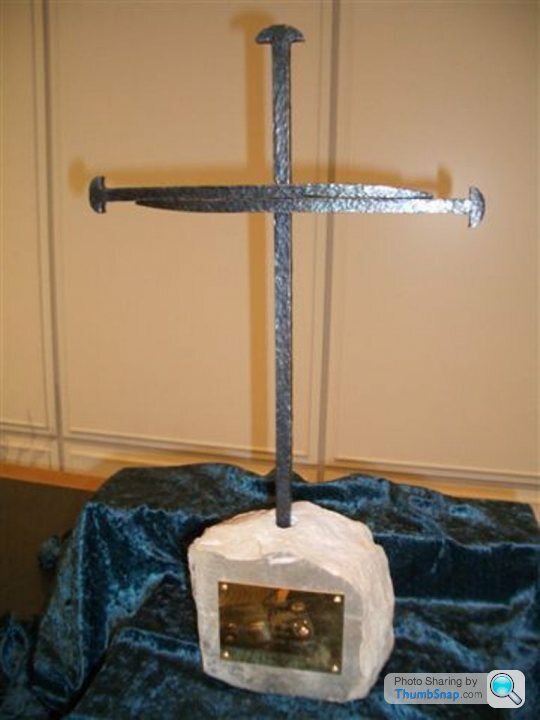
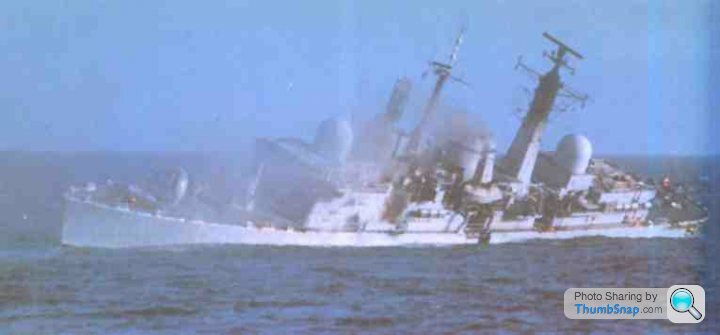
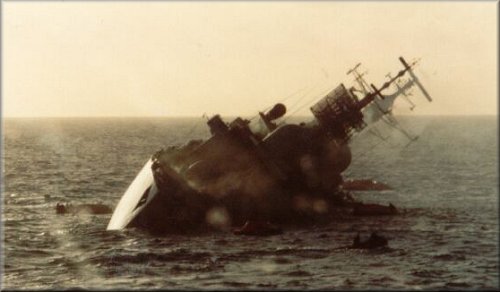
Read the Board of Inquiry report into the loss of HMS Coventry.
Roll of Honour
SD.
The loss of HMS Coventry
In the meantime, the other Skyhawk pair was aiming for Coventry. Again, the Sea Dart/Type 909 combo failed to lock, so the main gun was being fired optically, and everyone who had a personal weapon was banging merrily away.

Over on Broadsword, the air warfare crowd got the Sea Wolf system functioning again, and a proper lock. At the last second, however, Coventry, trying to manoeuvre to get a clear lock with the radar, crossed in front of Broadsword, masking her. The frigate couldn't shoot.
One bomb fell astern, the other three entered the port side and all exploded. Nineteen were killed instantly.

No order to abandon ship was given. Coventry indicated her intention to sink by capsizing early on, and it was un-necessary to incite people to get off.

The Cross of Nails went to the bottom of the sea with her.
All of Woodward's initial three air defence destroyers were now gone. After the war, divers were sent to the wreckage to retrieve the Cross of Nails.



Read the Board of Inquiry report into the loss of HMS Coventry.
Roll of Honour
- Marine Engineering Mechanic Frank O. Armes
- Chief Weapons Engineering Artificer John D. L. Caddy
- Marine Engineering Artificer Paul B. Callus
- Weapons Engineering Mechanic John K. Dobson
- Petty Officer Michael G. Fowler
- Weapons Engineering Mechanic Ian P. Hall
- Lieutenant Rodney R. Heath
- Laundryman Kye Ben Kwo
- Weapons Engineering Artificer David J. A. Ozbirn
- Lieutenant Commander Glen S. Robinson-Moltke
- Leading Radio Operator Bernard J. Still
- Marine Engineering Artificer Geoffrey L. J. Stockwell
- Weapons Engineering Artificer David A. Strickland
- Able Seaman Adrian D. Sunderland
- Marine Engineering Mechanician Stephen Tonkin
- Cook Ian Turnbull
- Weapons Engineering Artificer Philip P. White
- Weapons Engineering Artificer Ian R. Williams
- Marine Engineering Mechanic Paul T. Mills.
SD.
25th May Supplemental.
18:00. Carrying two of the last three of Argentina's air-launched Exocets, two Super-Etendards go looking for a carrier to hit, taking quite a detour in order to arrive from an unexpected direction.
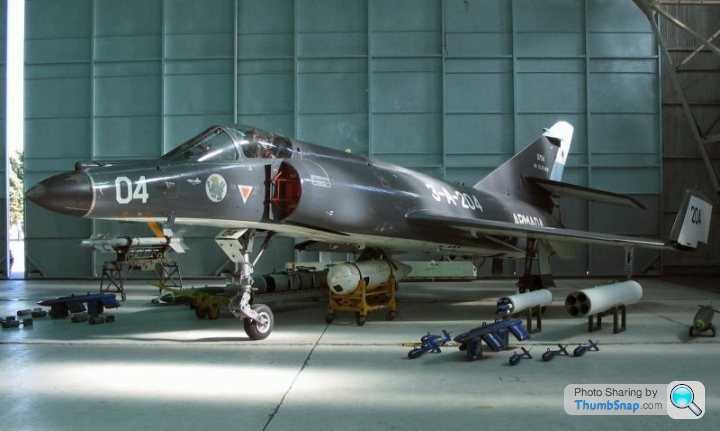
18:38. Finding a suitably large number of blips on the radar, the Etendards let loose, and turn for home. Their emissions are detected by HMS i]Exeter[/i], which sounds the alarm.
Initially, the missiles lock onto HMS Ambuscade, the just-arrived Type-21, but are decoyed away. After punching through the chaff clouds, they had adjusted course away from the carriers. Instead, they picked up the somewhat carrier-like 13,000 ton container vessel Atlantic Conveyor.
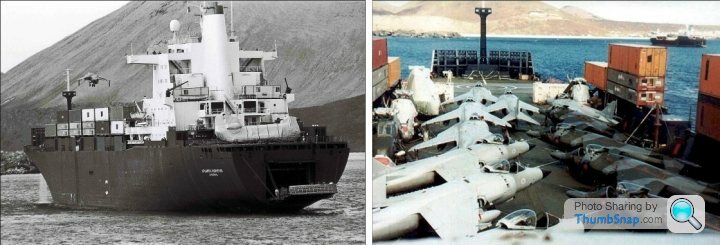

The image showing the missile tracks below is taken from a now declassified SECRET memo to cabinet on the 2nd of June 1982.
18:38. Finding a suitably large number of blips on the radar, the Etendards let loose, and turn for home. Their emissions are detected by HMS i]Exeter[/i], which sounds the alarm.
Initially, the missiles lock onto HMS Ambuscade, the just-arrived Type-21, but are decoyed away. After punching through the chaff clouds, they had adjusted course away from the carriers. Instead, they picked up the somewhat carrier-like 13,000 ton container vessel Atlantic Conveyor.

The image showing the missile tracks below is taken from a now declassified SECRET memo to cabinet on the 2nd of June 1982.
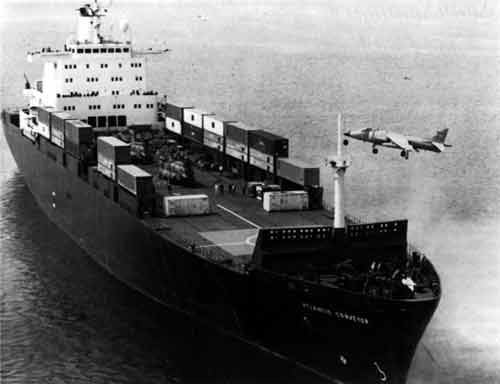
Though the Harriers she had transported had flown off to the carriers a few days prior, she was still heavily loaded.
1841. Both missiles impact on the port quarter, and a fire starts.
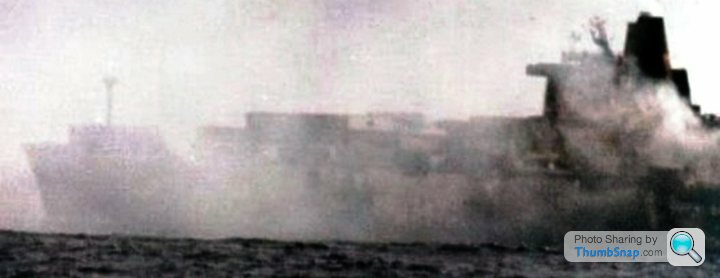
1920. With 11 men dead, and a fire creeping towards the cargo area (where, amongst all the fuel and other goodies, were six hundred bombs for the Harriers), the ship is abandoned. 134 men get off the ship.
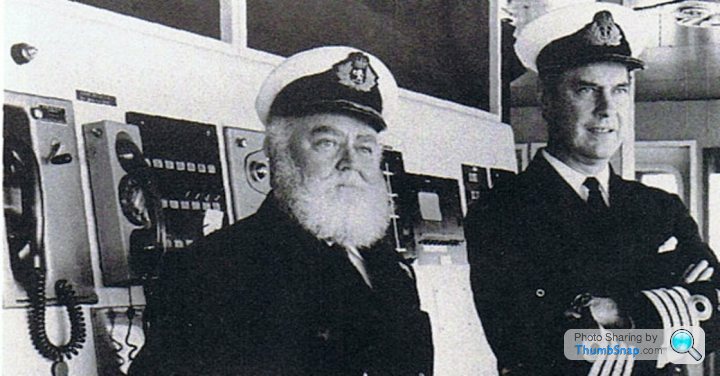
Last man off, again, was the ship's captain, Ian North, known as Captain Birdseye, for obvious reasons.
Although he made it off the ship, he never made it to a life raft. Despite being helped to one by the senior naval officer, Cpt Layard, a large wave broke over them. Layard resurfaced. The sixty-year-old North did not, claimed by the sea on which he had spent his adult life. The ship burns throughout the night. You will note the kill marking painted on the side of the Etendard above.
In addition to the various munitions aboard her, Atlantic Conveyor also had the entire materials loadout to construct a land base for the Harriers, relieving the pressure on the carriers, a whole load of spare parts for helicopters, three Lynxes, seven Wessexes, and four of the heavy-lift CH-47 Chinooks. One of those four, call-sign Bravo November happened to be in the air at the time, and escaped damage. This helicopter was quite possibly to become the most famous Chinook ever built. In the meantime, with the majority of the air lift capability now burning in the South Atlantic, the Marines and Army would now have to walk.
Read the Board of Inquiry report into the loss of SS Atlantic Conveyor
Roll of Honour
Merchant Navy
18:00. Carrying two of the last three of Argentina's air-launched Exocets, two Super-Etendards go looking for a carrier to hit, taking quite a detour in order to arrive from an unexpected direction.

18:38. Finding a suitably large number of blips on the radar, the Etendards let loose, and turn for home. Their emissions are detected by HMS i]Exeter[/i], which sounds the alarm.
Initially, the missiles lock onto HMS Ambuscade, the just-arrived Type-21, but are decoyed away. After punching through the chaff clouds, they had adjusted course away from the carriers. Instead, they picked up the somewhat carrier-like 13,000 ton container vessel Atlantic Conveyor.


The image showing the missile tracks below is taken from a now declassified SECRET memo to cabinet on the 2nd of June 1982.
18:38. Finding a suitably large number of blips on the radar, the Etendards let loose, and turn for home. Their emissions are detected by HMS i]Exeter[/i], which sounds the alarm.
Initially, the missiles lock onto HMS Ambuscade, the just-arrived Type-21, but are decoyed away. After punching through the chaff clouds, they had adjusted course away from the carriers. Instead, they picked up the somewhat carrier-like 13,000 ton container vessel Atlantic Conveyor.

The image showing the missile tracks below is taken from a now declassified SECRET memo to cabinet on the 2nd of June 1982.

Though the Harriers she had transported had flown off to the carriers a few days prior, she was still heavily loaded.
1841. Both missiles impact on the port quarter, and a fire starts.

1920. With 11 men dead, and a fire creeping towards the cargo area (where, amongst all the fuel and other goodies, were six hundred bombs for the Harriers), the ship is abandoned. 134 men get off the ship.

Last man off, again, was the ship's captain, Ian North, known as Captain Birdseye, for obvious reasons.
Although he made it off the ship, he never made it to a life raft. Despite being helped to one by the senior naval officer, Cpt Layard, a large wave broke over them. Layard resurfaced. The sixty-year-old North did not, claimed by the sea on which he had spent his adult life. The ship burns throughout the night. You will note the kill marking painted on the side of the Etendard above.
In addition to the various munitions aboard her, Atlantic Conveyor also had the entire materials loadout to construct a land base for the Harriers, relieving the pressure on the carriers, a whole load of spare parts for helicopters, three Lynxes, seven Wessexes, and four of the heavy-lift CH-47 Chinooks. One of those four, call-sign Bravo November happened to be in the air at the time, and escaped damage. This helicopter was quite possibly to become the most famous Chinook ever built. In the meantime, with the majority of the air lift capability now burning in the South Atlantic, the Marines and Army would now have to walk.
Read the Board of Inquiry report into the loss of SS Atlantic Conveyor
Roll of Honour
Merchant Navy
- Bosun John B. Dobson
- Mechanic Frank Foulkes
- Steward David R. S. Hawkins
- Mechanic James Hughes
- Captain Ian H. North, D.S.C.
- Seaman Chan Chi Shing
- Mechanic Ernest M. Vickers
- 1st Radio Officer Ronald Hoole
- Seaman Ng Por
- Chief Petty Officer Edmund Flanagan
- Air Engineering Mechanic (R) Adrian J. Anslow
- Leading Air Engineering Mechanic (L) Don L. Price
26th May
The Carrier Battle Group moved to the eastern section of the TEZ during the night of 25th/26th May.
The Group was joined by HMS Avenger, Active, Bristol, Cardiff, Minerva and Penelope.
The Battle Group spent most of the day replenishing from the RFAs.
HMS Ambuscade was detached to inspect the derelict Atlantic Conveyor.
With the navy really now quite irked at the Army and Marines just sitting in San Carlos while they run out of ships, pressure also starts mounting in London for some good news to report to the public for a change.
Brigadier Thompson is summoned to the satellite terminal at Ajax Bay, and given a talking to by London.
“Start walking. And, by the way, capture Goose Green, it's the closest place that can be captured.
No, we don't care that the Argentinians have just reinforced the place with the 12th Regiment, we need good news, and we need it fast.
Capture Goose Green.”
Afteroon: 2 Para sets out a-walking the 13 miles or so to Goose Green. This is duly reported by the BBC. On the World Service - in Argentina. Combined with other instances, such as the report broadcast on 23rd May that Argentine bombs were not exploding on impact, the British military have ever since been somewhat distrustful of the organisation.
The other commanders are given their marching orders to other locations, each man carrying some 120lbs of equipment apiece. Stanley is about 60 miles away over open, not-too-nice terrain. Some commanders believe that even if the troops manage to make it, they'll be too exhausted to fight a battle at the other end.
UN Security Council Resolution 505 instructs de Cuellar to seek negotiated settlement.
I'd like to thank all the other contributors to this thread who have given great technical and personal insights into tactics and weapon systems in use at the time. Like many others I read and watched the reports of Harriers "VIFFing" and never actually thought it might actually be a bad idea - to a 15 year old it just sounded absolutely impressive. I wonder if any of these reports may have impacted on Argentinean air warfare tactics - expecting the Harrier to slam the brakes on in front of you must have been in the minds of the pilots. Does anyone have any actual knowledge of this? The contacts I made many years ago for the original thread were mainly naval personnel - it really would be interesting to hear the views of professional pilots with regard to the psychological effect the tactic may have had.
SD.
The Carrier Battle Group moved to the eastern section of the TEZ during the night of 25th/26th May.
The Group was joined by HMS Avenger, Active, Bristol, Cardiff, Minerva and Penelope.
The Battle Group spent most of the day replenishing from the RFAs.
HMS Ambuscade was detached to inspect the derelict Atlantic Conveyor.
With the navy really now quite irked at the Army and Marines just sitting in San Carlos while they run out of ships, pressure also starts mounting in London for some good news to report to the public for a change.
Brigadier Thompson is summoned to the satellite terminal at Ajax Bay, and given a talking to by London.
“Start walking. And, by the way, capture Goose Green, it's the closest place that can be captured.
No, we don't care that the Argentinians have just reinforced the place with the 12th Regiment, we need good news, and we need it fast.
Capture Goose Green.”
Afteroon: 2 Para sets out a-walking the 13 miles or so to Goose Green. This is duly reported by the BBC. On the World Service - in Argentina. Combined with other instances, such as the report broadcast on 23rd May that Argentine bombs were not exploding on impact, the British military have ever since been somewhat distrustful of the organisation.
The other commanders are given their marching orders to other locations, each man carrying some 120lbs of equipment apiece. Stanley is about 60 miles away over open, not-too-nice terrain. Some commanders believe that even if the troops manage to make it, they'll be too exhausted to fight a battle at the other end.
UN Security Council Resolution 505 instructs de Cuellar to seek negotiated settlement.
I'd like to thank all the other contributors to this thread who have given great technical and personal insights into tactics and weapon systems in use at the time. Like many others I read and watched the reports of Harriers "VIFFing" and never actually thought it might actually be a bad idea - to a 15 year old it just sounded absolutely impressive. I wonder if any of these reports may have impacted on Argentinean air warfare tactics - expecting the Harrier to slam the brakes on in front of you must have been in the minds of the pilots. Does anyone have any actual knowledge of this? The contacts I made many years ago for the original thread were mainly naval personnel - it really would be interesting to hear the views of professional pilots with regard to the psychological effect the tactic may have had.
SD.
27th May
The Amphibious Phase was now complete, with the Brigade ashore and virtually self-sufficient.
Sir Geraint and Europic Ferry left San Carlos during the night.
B Company, 41 Cdo, found the first Argentine presence finding a Captain de Corbeta (Equivalent to LtCdr, OF-3) of the Argentine Marine Corps.
Three 105mm Light Guns are helicoptered to Camilla Creek House, some eight miles from Goose Green. Ammunition is 320 rounds per gun. Not bad for twelve Sea King lifts.
With the general enemy area under observation by the patrols, 2 Para called in a Harrier GR3 strike against both gun and infantry positions on the hills above Goose Green. A Forward Air Controller with 2 Para would operate through an air liaison officer at Brigade Headquarters. Unfortunately when the weather finally enabled the aircraft to make their sortie, the FAC with the patrols had been called back to the Battalion HQ and was not on hand to liaise with them. Wing Commander Peter Squire, the commander of the Harrier GR3 force, and Squadron Leader Bob Iveson left HMS Hermes to make the attack and two passes were made over the Argentine positions; then Sqn Ldr Iveson decided to make a third.
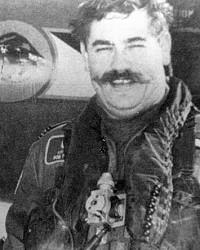
Sqn Ldr Iveson
His Harrier was hit by two 35 mm shells which knocked out his controls and started a fire in the cockpit. At around 100 ft, he immediately pulled the ejection handle and left the cockpit while the Harrier was doing around 450 knots and his aircraft exploded in mid-air shortly afterwards; he hit the ground after being under the parachute for only ten or fifteen seconds. He suffered spinal compression and wind-blast damage to his eyes but hit the ground sufficiently far from the Argentine positions to make good his escape and was picked up two days later by a Royal Navy helicopter.
Sqn Ldr Iveson's father (Thomas Clifford "Tony" Iveson) was in 617 Squadron as well as participating in the Battle of Britain (616 Sqn)
18:00. First Paras leave Camilla House, heading for their start-point, four miles distant. Argentine artillery lands nearby, but is unaimed.
In a column of troops five miles long, 3 Para and 45 Cdo make 13 miles before calling it quits for the night.
Four A-4s attack San Carlos ground positions.
40mm Bofors guns from HMS Fearless shoot down Lt Velasco, who ejects and is captured.
D Squadron, SAS is helicoptered to Mount Kent.
A second attack dropped more bombs in the afternoon. The air raids began in the late afternoon. Shore facilities in San Carlos bridgehead attacked for the first time, leaving 2 unexploded bombs in the Field Hospital: 2 Argentine aircraft were destroyed. The bombs remained in the Field Hospital until daylight when a RAF bomb disposal team could examine them.
All patients who were fit to be moved were evacuated to HMS Intrepid. Flight Lieutenant A. Swan RAF, slept beside one of the bombs, to reassure the patients and staff who had to remain. These were the only low-level raids to concentrate on the British land forces in San Carlos Water.
The Battle Group was affected by fog, low cloud and rain. This left the carriers unable to operate fighters and only 35 CAP sorties were flown off the carriers during the day.
Two GR3s attacked Port Stanley airfield at noon, using delayed action 1,000 lb bombs with the intention of disrupting supply flights during the night.
HMS Penelope and Avenger were detached to form an anti-surface screen.
The Irishman had the Atlantic Conveyor in tow by mid-evening. Atlantic Conveyor's ordnance had exploded, blowing her bows off, permitting flooding and giving her a 15 degree list to starboard.
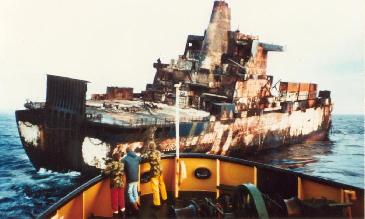
Atlantic Conveyor as seen from the tug [Irishman[/i]
The tow parted after half an hour, Able Seamen D. P. Betts and G. Bales went across to reconnect a line (as a consequence, the two men were awarded the British Empire Medal). However, as the fog descended, the Irishman lost sight of the Atlantic Conveyor and had no warning when the ship suddenly plunged late that night. The Irishman made a sweep of the area but found only three large containers floating on the surface. The Captain reported the loss of the ship and its position. The ship was the first British merchant vessel lost at sea to enemy fire since World War II.
Elk, laden with stores made a replenishment run into San Carlos. She was escorted by HMS Ambuscade and RFA Tidepool with HMS Plymouth joining them for the last stage.
HMS Glamorgan, Avenger, Alacrity, Arrow and Yarmouth detached from the Battle Group as darkness fell to bombard inland targets.
263 survivors from HMS Sheffield arrived home in UK.
SD.
The Amphibious Phase was now complete, with the Brigade ashore and virtually self-sufficient.
Sir Geraint and Europic Ferry left San Carlos during the night.
B Company, 41 Cdo, found the first Argentine presence finding a Captain de Corbeta (Equivalent to LtCdr, OF-3) of the Argentine Marine Corps.
Three 105mm Light Guns are helicoptered to Camilla Creek House, some eight miles from Goose Green. Ammunition is 320 rounds per gun. Not bad for twelve Sea King lifts.
With the general enemy area under observation by the patrols, 2 Para called in a Harrier GR3 strike against both gun and infantry positions on the hills above Goose Green. A Forward Air Controller with 2 Para would operate through an air liaison officer at Brigade Headquarters. Unfortunately when the weather finally enabled the aircraft to make their sortie, the FAC with the patrols had been called back to the Battalion HQ and was not on hand to liaise with them. Wing Commander Peter Squire, the commander of the Harrier GR3 force, and Squadron Leader Bob Iveson left HMS Hermes to make the attack and two passes were made over the Argentine positions; then Sqn Ldr Iveson decided to make a third.

Sqn Ldr Iveson
His Harrier was hit by two 35 mm shells which knocked out his controls and started a fire in the cockpit. At around 100 ft, he immediately pulled the ejection handle and left the cockpit while the Harrier was doing around 450 knots and his aircraft exploded in mid-air shortly afterwards; he hit the ground after being under the parachute for only ten or fifteen seconds. He suffered spinal compression and wind-blast damage to his eyes but hit the ground sufficiently far from the Argentine positions to make good his escape and was picked up two days later by a Royal Navy helicopter.
Sqn Ldr Iveson's father (Thomas Clifford "Tony" Iveson) was in 617 Squadron as well as participating in the Battle of Britain (616 Sqn)
18:00. First Paras leave Camilla House, heading for their start-point, four miles distant. Argentine artillery lands nearby, but is unaimed.
In a column of troops five miles long, 3 Para and 45 Cdo make 13 miles before calling it quits for the night.
Four A-4s attack San Carlos ground positions.
40mm Bofors guns from HMS Fearless shoot down Lt Velasco, who ejects and is captured.
D Squadron, SAS is helicoptered to Mount Kent.
A second attack dropped more bombs in the afternoon. The air raids began in the late afternoon. Shore facilities in San Carlos bridgehead attacked for the first time, leaving 2 unexploded bombs in the Field Hospital: 2 Argentine aircraft were destroyed. The bombs remained in the Field Hospital until daylight when a RAF bomb disposal team could examine them.
All patients who were fit to be moved were evacuated to HMS Intrepid. Flight Lieutenant A. Swan RAF, slept beside one of the bombs, to reassure the patients and staff who had to remain. These were the only low-level raids to concentrate on the British land forces in San Carlos Water.
The Battle Group was affected by fog, low cloud and rain. This left the carriers unable to operate fighters and only 35 CAP sorties were flown off the carriers during the day.
Two GR3s attacked Port Stanley airfield at noon, using delayed action 1,000 lb bombs with the intention of disrupting supply flights during the night.
HMS Penelope and Avenger were detached to form an anti-surface screen.
The Irishman had the Atlantic Conveyor in tow by mid-evening. Atlantic Conveyor's ordnance had exploded, blowing her bows off, permitting flooding and giving her a 15 degree list to starboard.

Atlantic Conveyor as seen from the tug [Irishman[/i]
The tow parted after half an hour, Able Seamen D. P. Betts and G. Bales went across to reconnect a line (as a consequence, the two men were awarded the British Empire Medal). However, as the fog descended, the Irishman lost sight of the Atlantic Conveyor and had no warning when the ship suddenly plunged late that night. The Irishman made a sweep of the area but found only three large containers floating on the surface. The Captain reported the loss of the ship and its position. The ship was the first British merchant vessel lost at sea to enemy fire since World War II.
Elk, laden with stores made a replenishment run into San Carlos. She was escorted by HMS Ambuscade and RFA Tidepool with HMS Plymouth joining them for the last stage.
HMS Glamorgan, Avenger, Alacrity, Arrow and Yarmouth detached from the Battle Group as darkness fell to bombard inland targets.
263 survivors from HMS Sheffield arrived home in UK.
SD.
Muffster said:
I joined the RN in 1992 and been to the FI a number of times over the years. Latterly on the Endurance during a long deployment to the Antarctic in 2007 which was excellent. Sadly the Endurance suffered a catastrophic flood on 16th December 2008 in the Strait of Magellan and when eventually recovered back to the UK was never repaired, deemed too costly. The ship was eventually scrapped last year after rotting away in Portsmouth dockyard for 7 years after the indecent.
Thanks Muffster.I'm sure you have read the BOI report into the incident on Endurance - for those who are interested it can be found here.
https://1drv.ms/b/s!Ane9lOTY5nFrrmyR8iWrU_d-EP2L
SD.
Gassing Station | The Lounge | Top of Page | What's New | My Stuff



